Y Gantry
Intro
The purpose of this work instruction is to explain the assembly process for the LumenPnP v4 Left-Side Y-Gantry (y-gantry-left). This document also serves as the work instruction for the y-gantry-right subassemby, as this is simply a mirror of the left-side.
Create Y-Gantry Subassembly
- Remove any stringing from the print with a heat gun
- Insert 6x
m5-hex-nutinto the following region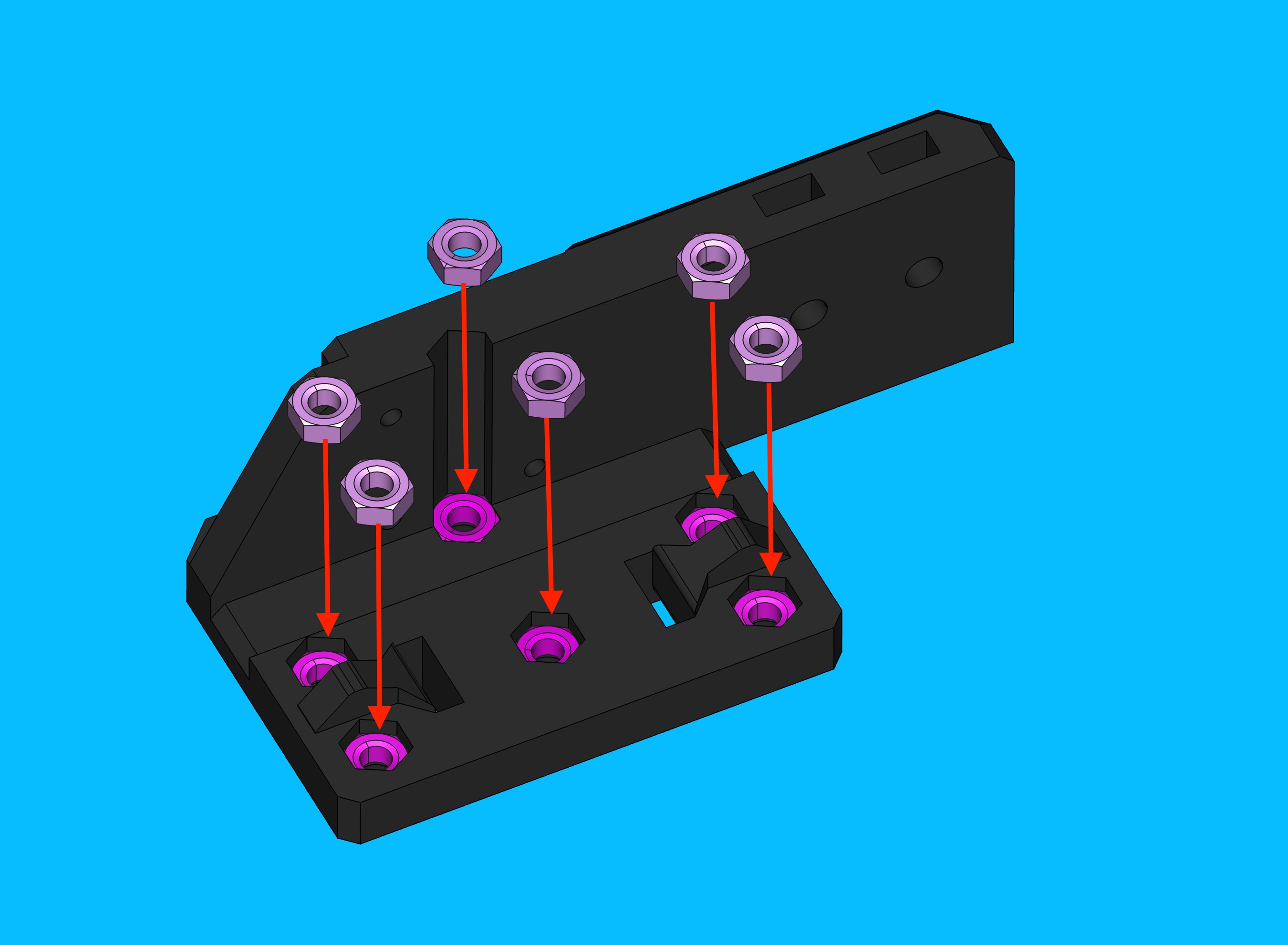
- Install 2x
m5-square-nutinto the location shown below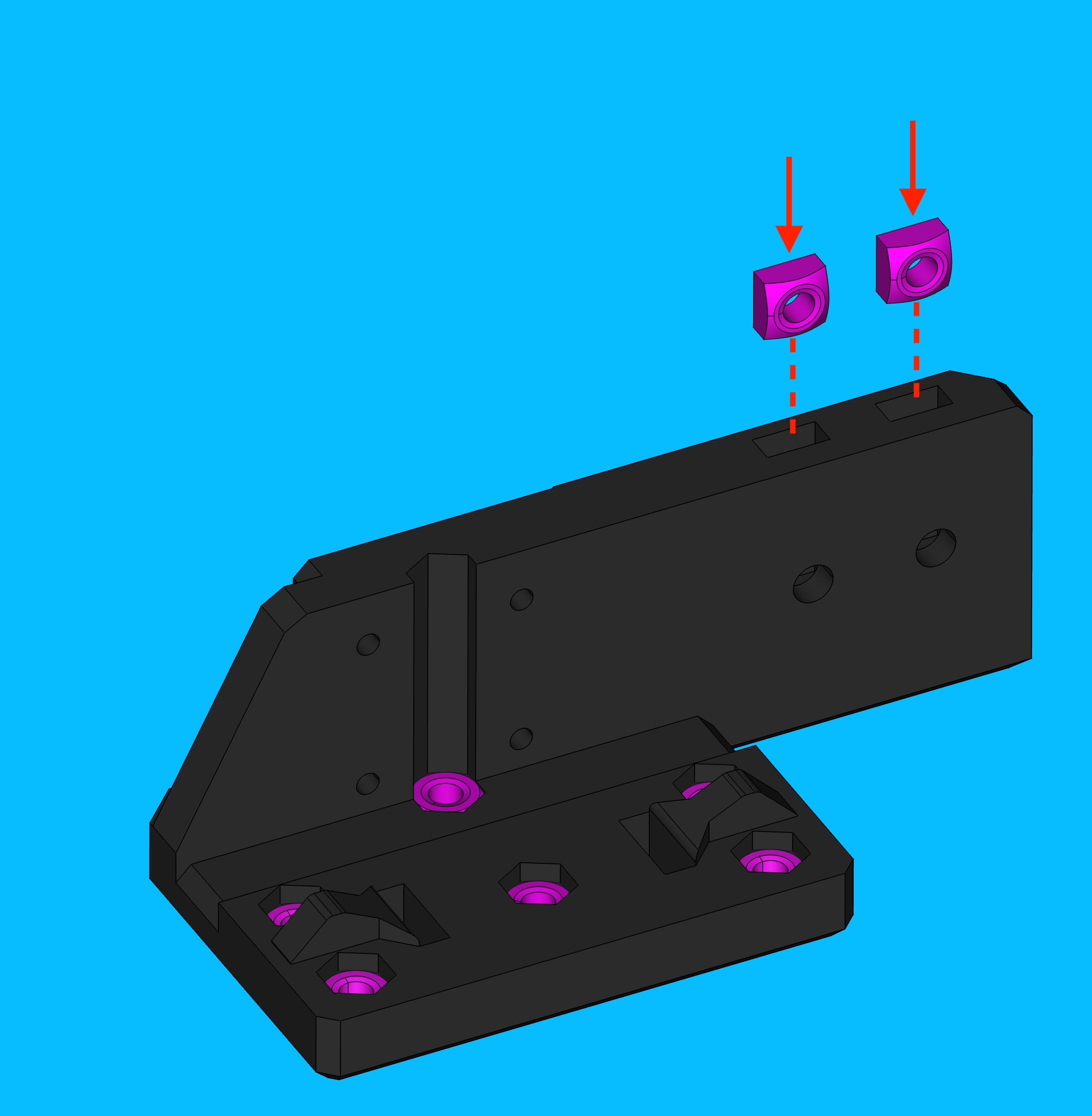
Create Front-Left-Leg Subassembly
Prepare front-left-leg
- Remove any stringing from the print with a heat gun
-
Insert 2x
m5-hex-nutinto bottom of leg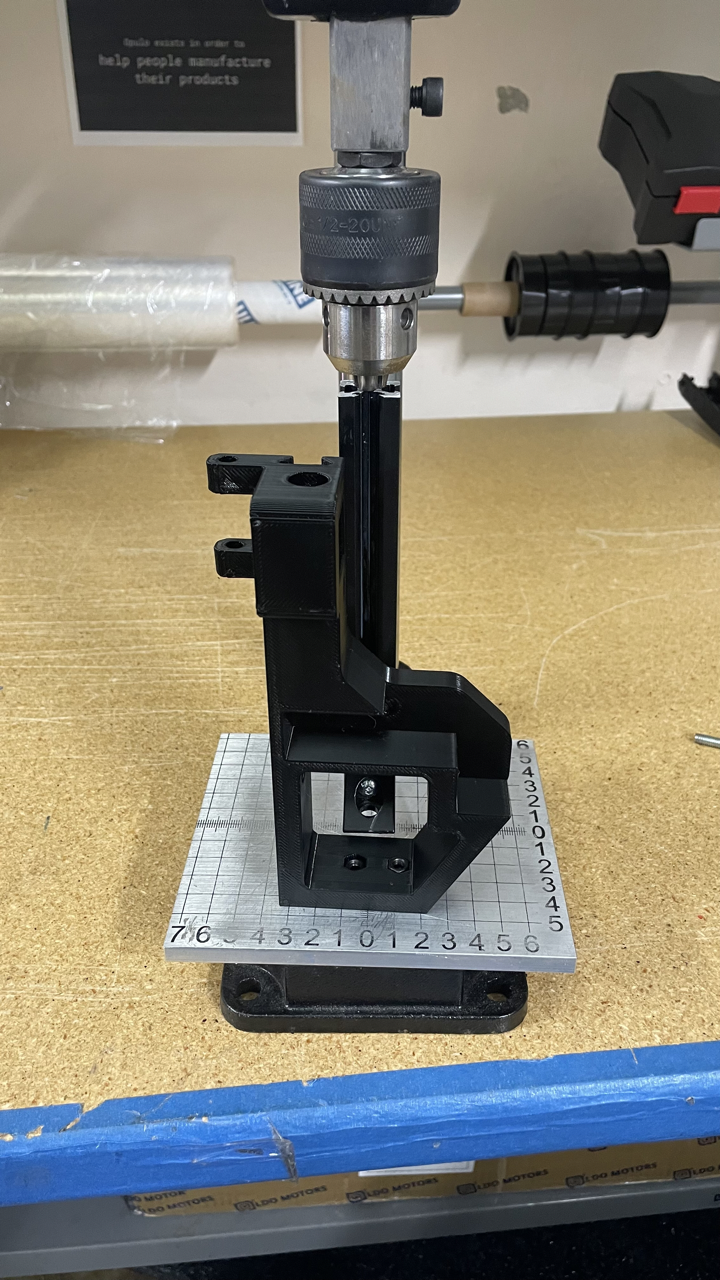

-
Insert 1x
m5-square-nutnear extrusion pocket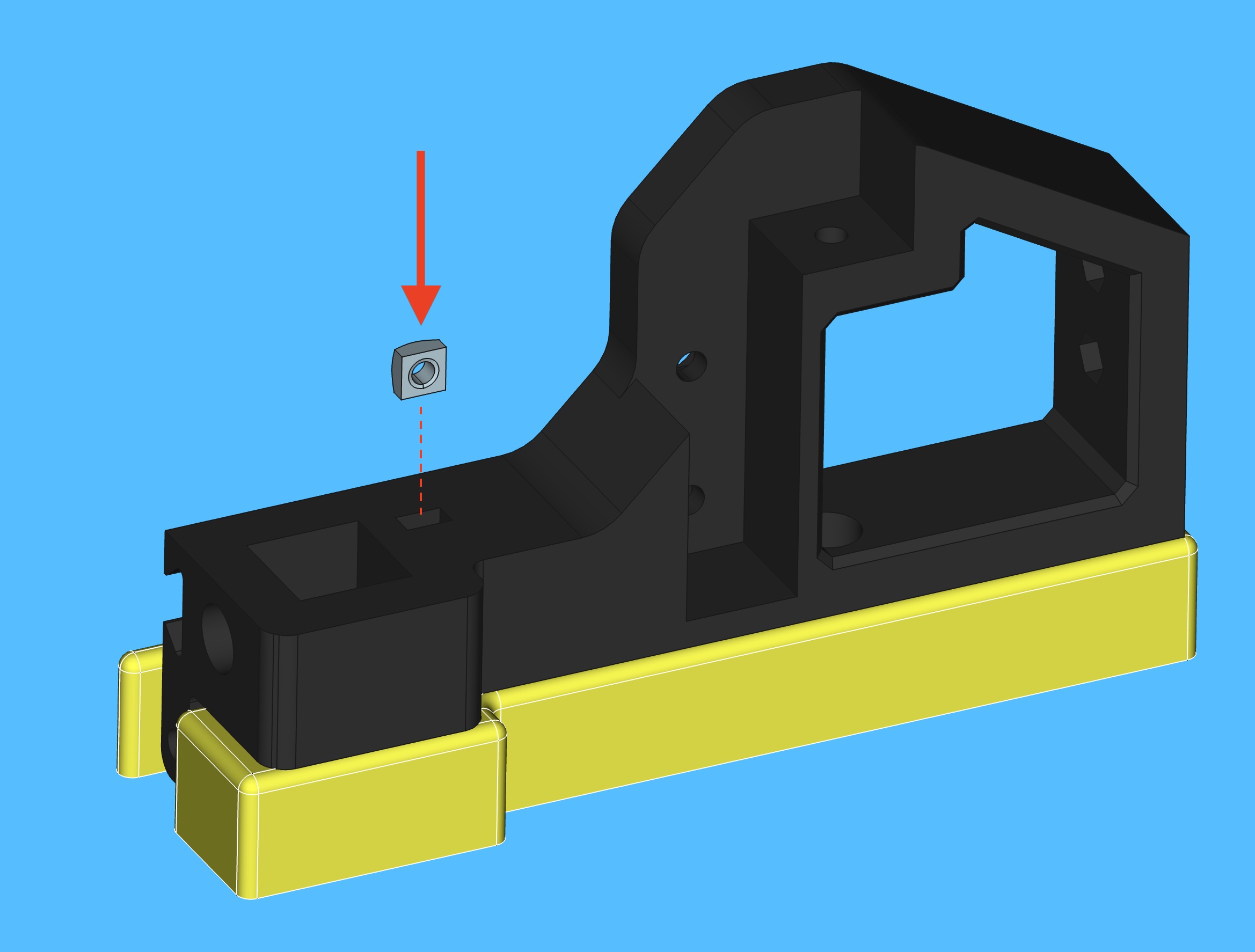
-
Insert 1x
m5-nylock-hex-nutinto in the underside ofbelt-tensioner-armmounting post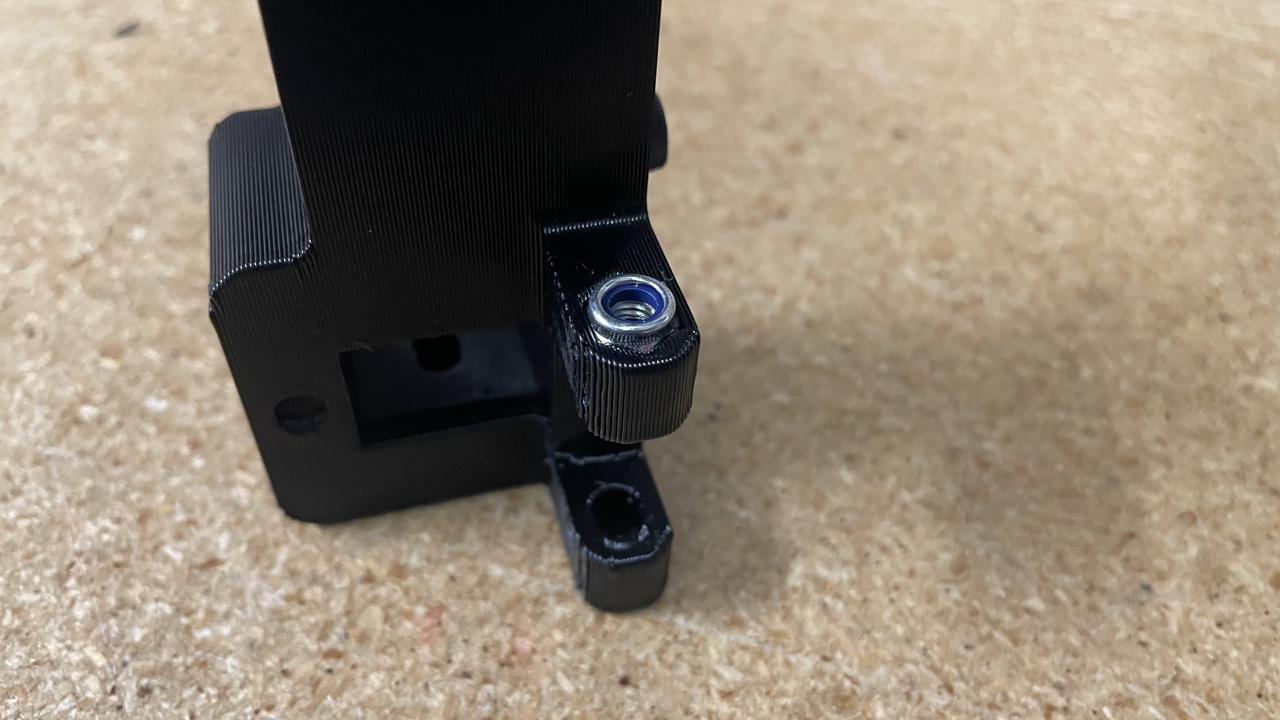
Prepare belt-tensioner-arm
- Press an
M3-hex-nutinto thebelt-tension-armwith aarbor-press-jig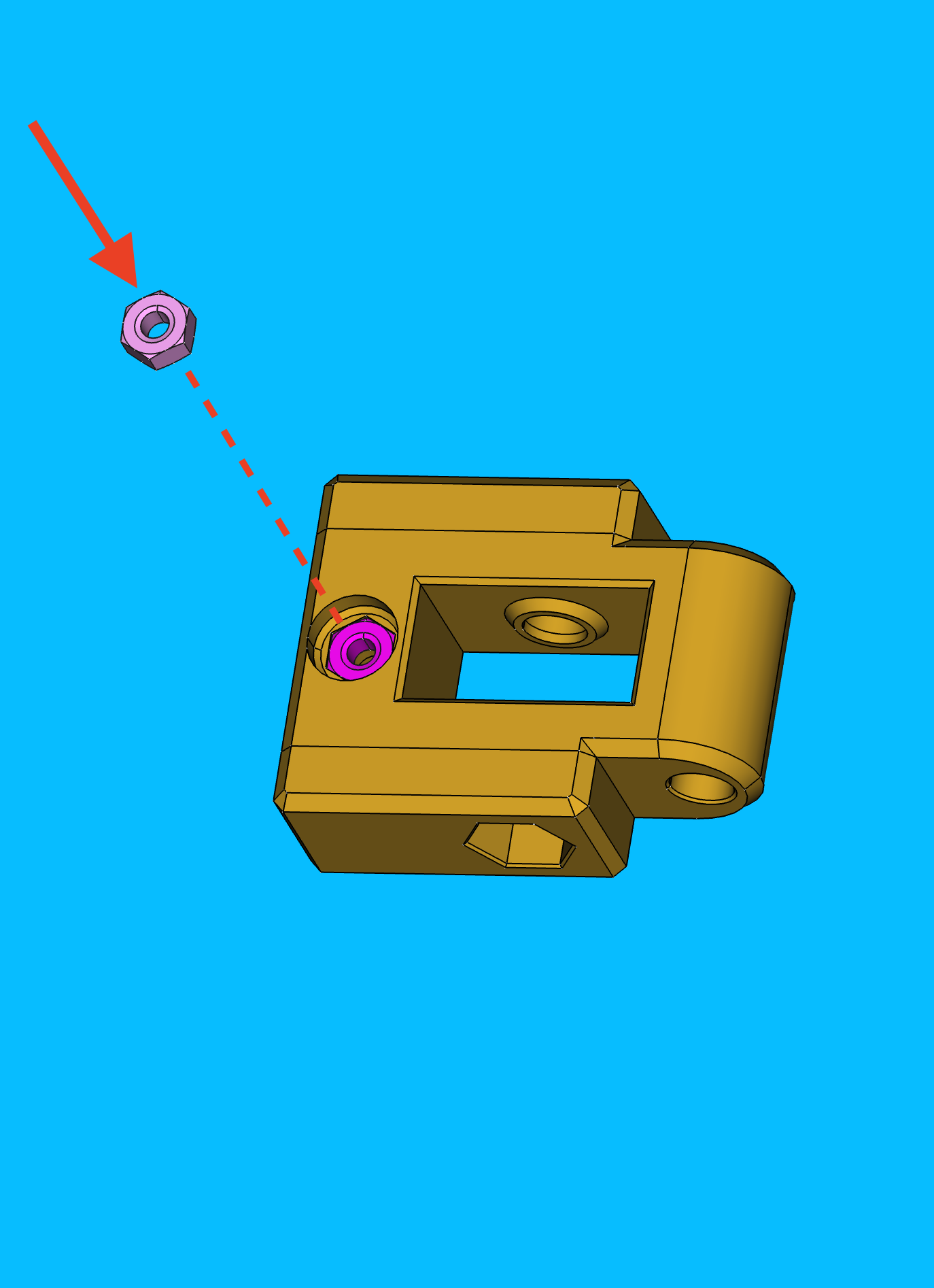
- Thread a
M3x16-boltthrough thebelt-tension-arm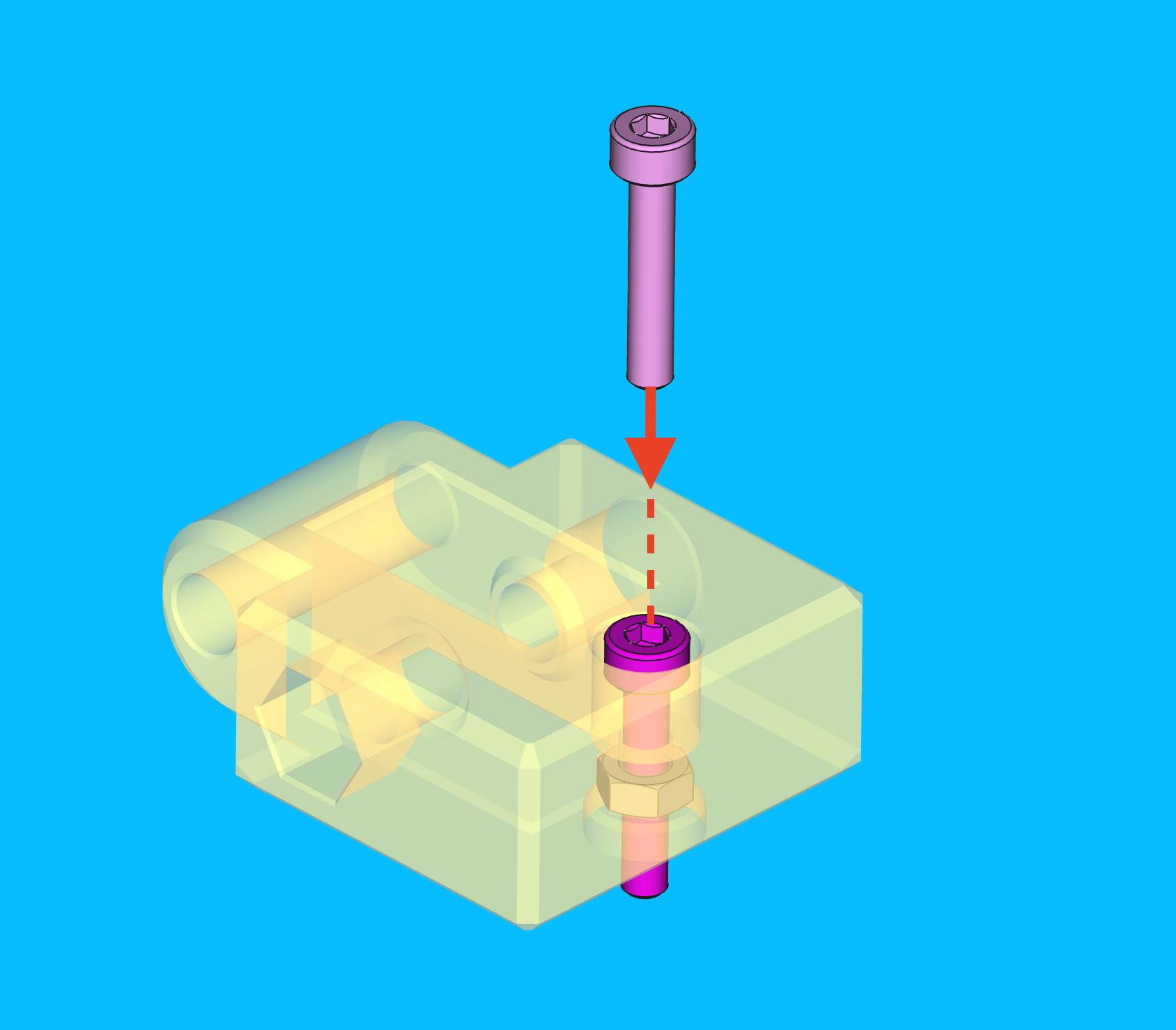
-
Thread a
M3-acorn-nutonto the end of the bolt- The
M3-acorn-nutandM3-hex-nutshould be on the same side of thebelt-tensioner-arm - Tighten the
M3-acorn-nutonto theM3x16-boltwith a 5.5mm socket and an allen wrench



- The
-
Rotate the
M3x16-boltuntil theM3-acorn-nutis loosely resting against theM3-hex-nutThis ensures the
belt-tensioner-armis installed with it's adjustment range fully available for when it's time to tensionGT2-belt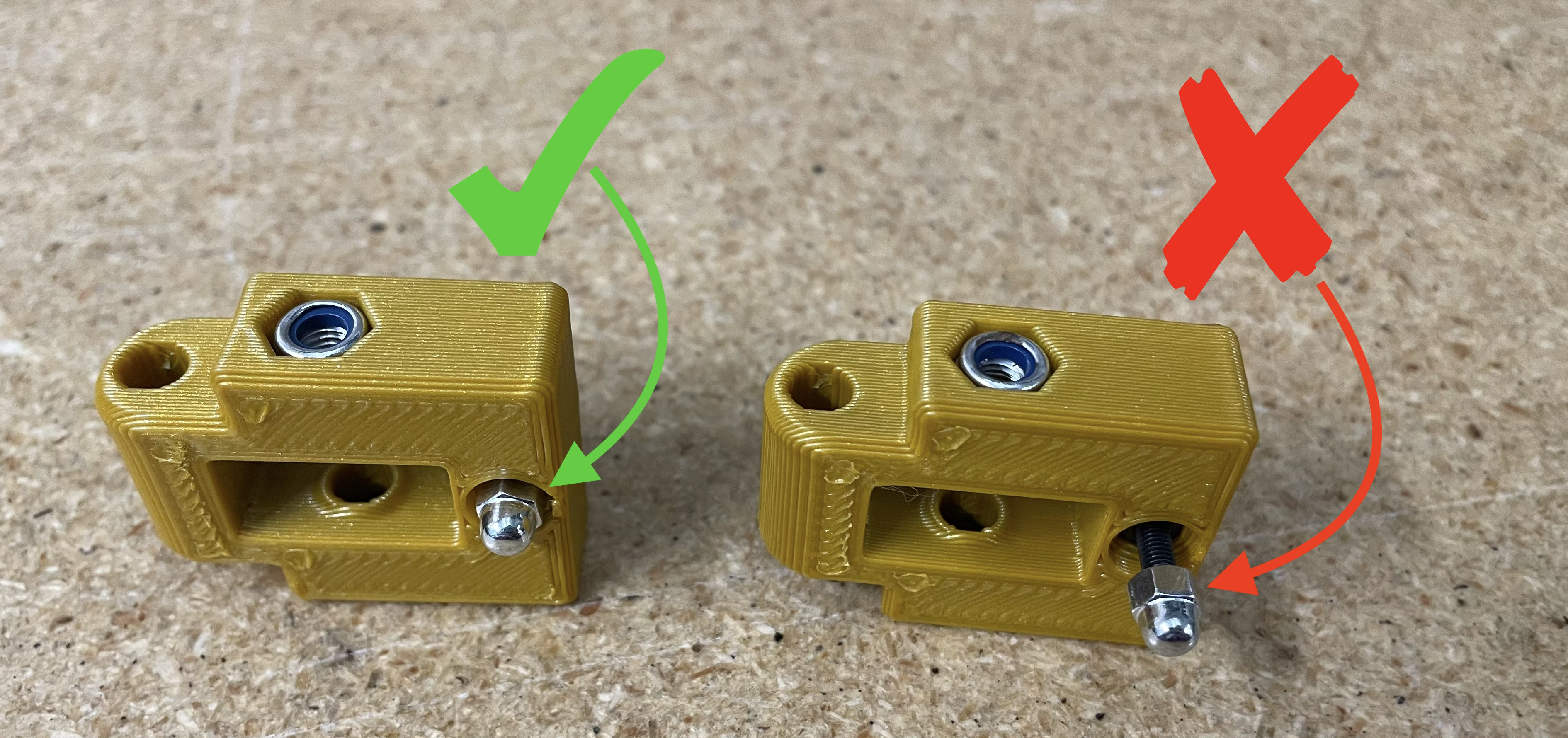
-
Insert a
M5-nylock-hex-nutintobelt-tension-arm's hex-nut pocket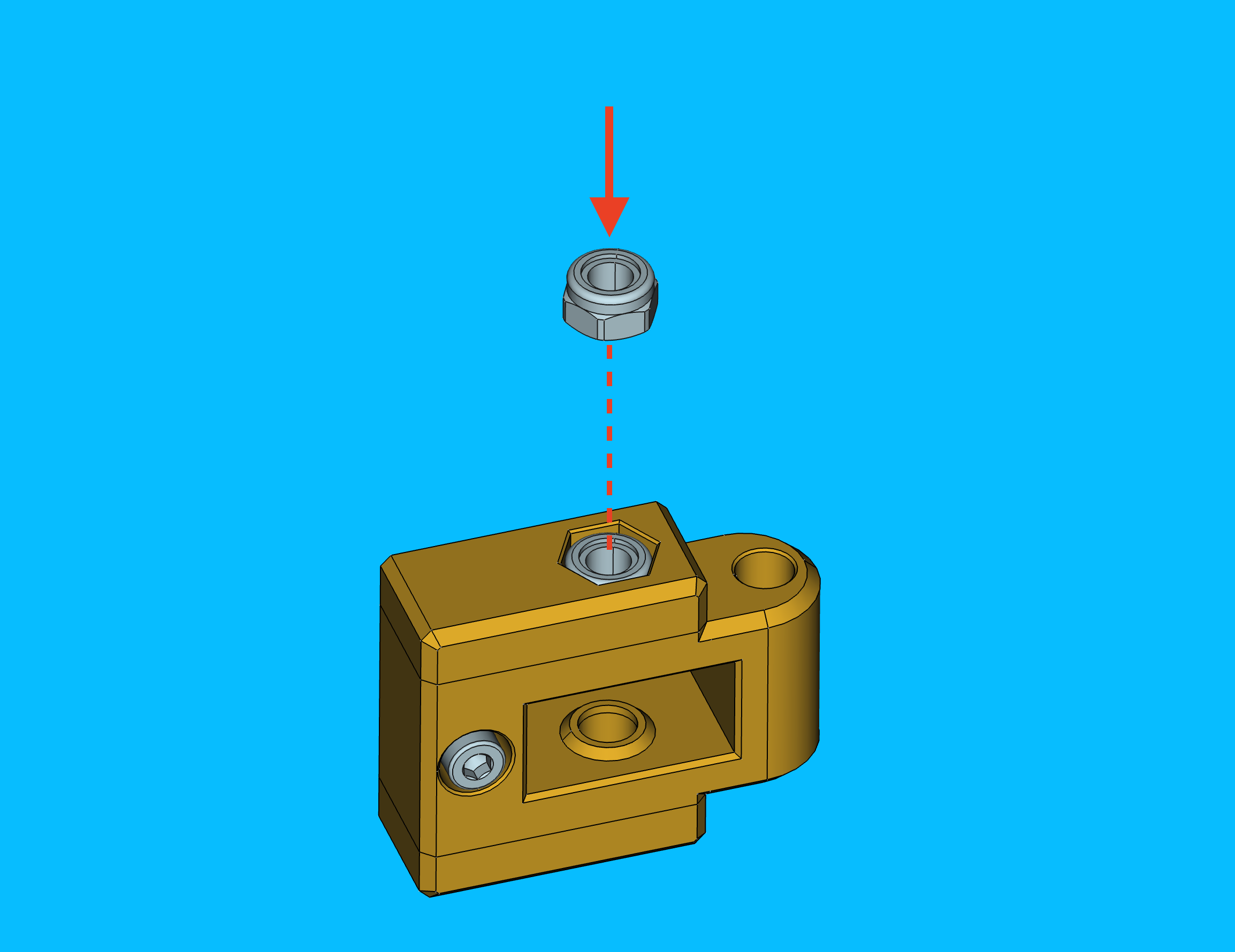
-
Slide a
GT2-idler-pulleyinto thebelt-tensioner-arm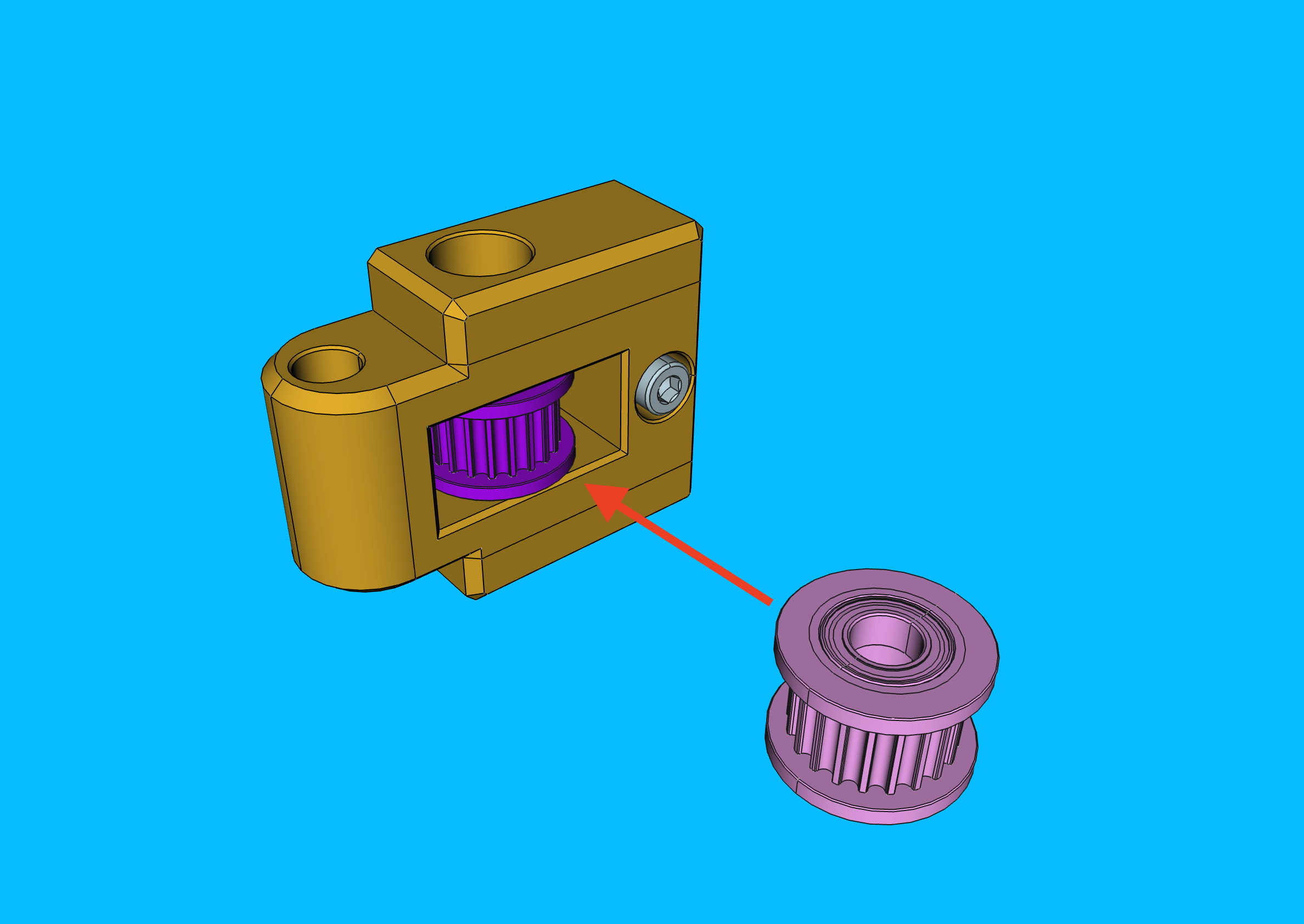
Note that the
GT2-idler-pulleyis symmetrical, so it's orientation does not matter -
Install a
M5x25-boltinto thebelt-tensioner-armto secure theGT2-idler-pulleyin place- Avoid over tightening this bolt as the
GT2-idler-pulleyshould be able to spin freely without resistance - The bolt should, however, be tightened enough to eliminate lateral pulley movement within the
belt-tensioner-arm

- Avoid over tightening this bolt as the
Install belt-tensioner-arm onto front-left-leg
-
Add a drop of
ptfe-silicone-lubricantto both sides ofbelt-tensioner-arm's pivot point -
Install
belt-tensioner-armontofront-left-leg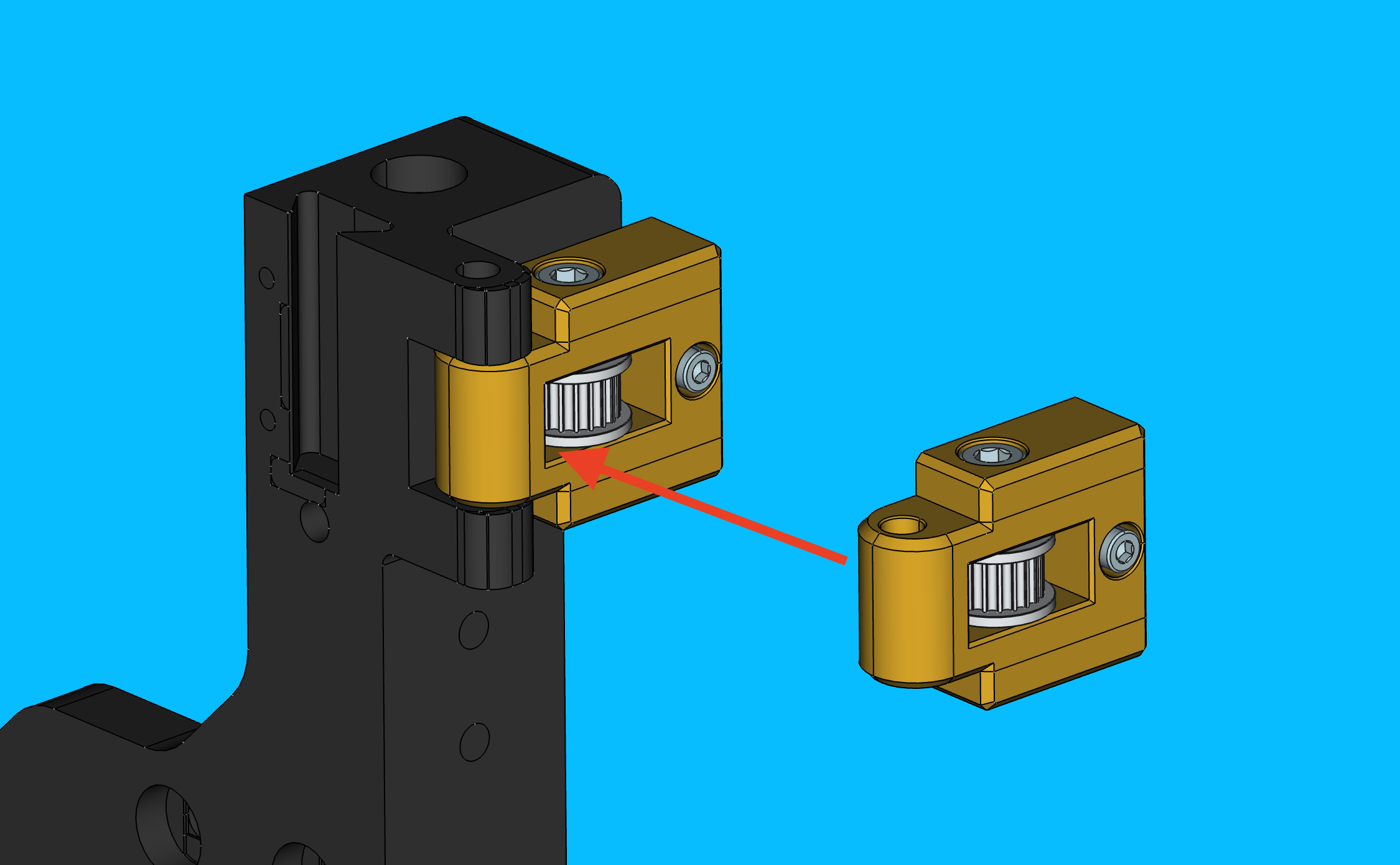
-
Secure the
belt-tensioner-armontofront-left-legwith aM5x40-bolt- Avoid over tightening this bolt as the
belt-tensioner-armshould be able to pivot freely without much resistance

- Avoid over tightening this bolt as the
-
The completed
front-left-legshould match the image shown below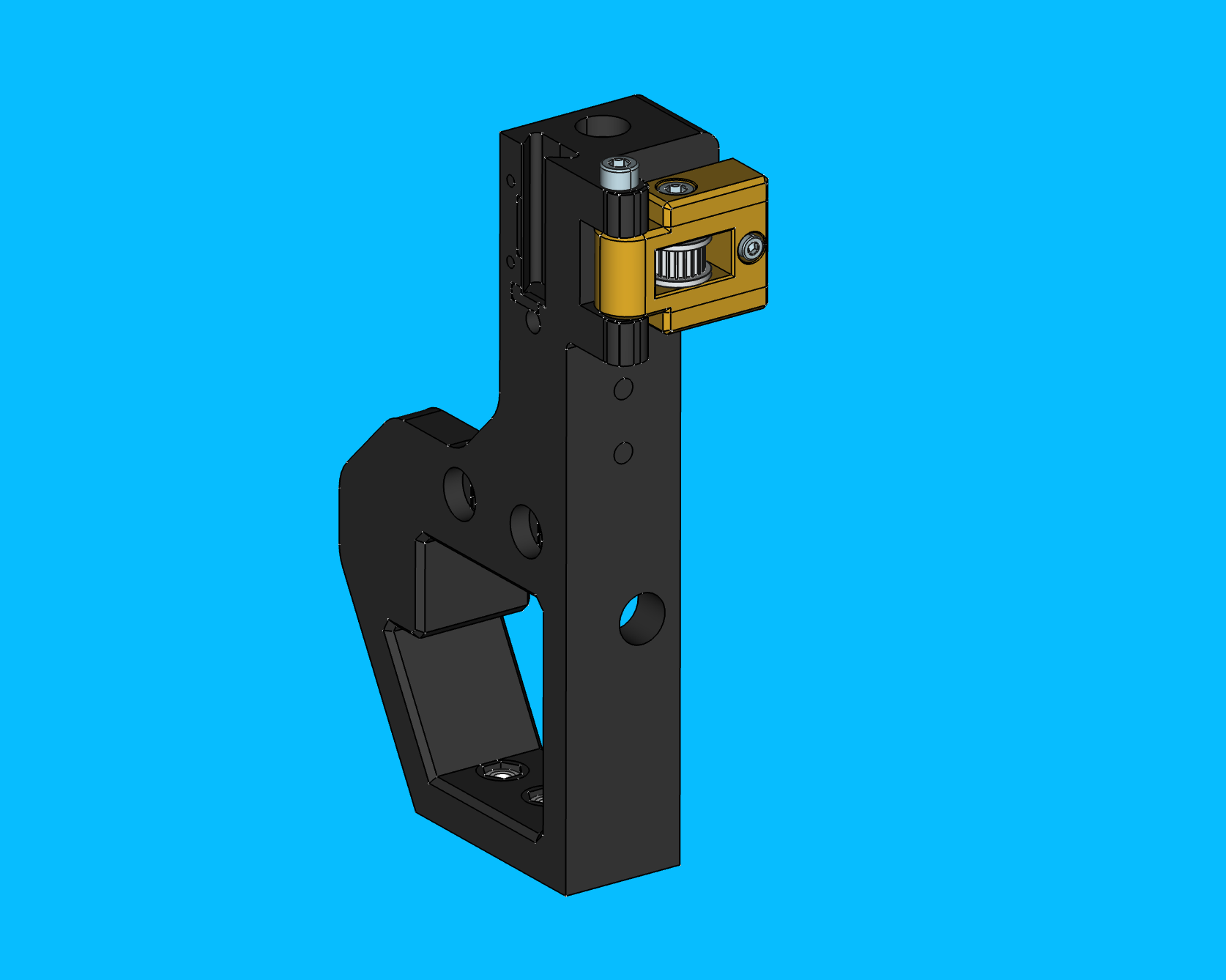
Create Back-Left-Leg Subassembly
Prepare back-leg
- Remove any stringing from the 3D print with a heat gun
- Insert an
m5-hex-nutinto the bottom of theback-leg3D print- Finger strength should be sufficient to install this fastener into position
Glue if needed
Add a drop of loctite to the region if the fastener fit is looser than normal and seems at risk of falling out in transit
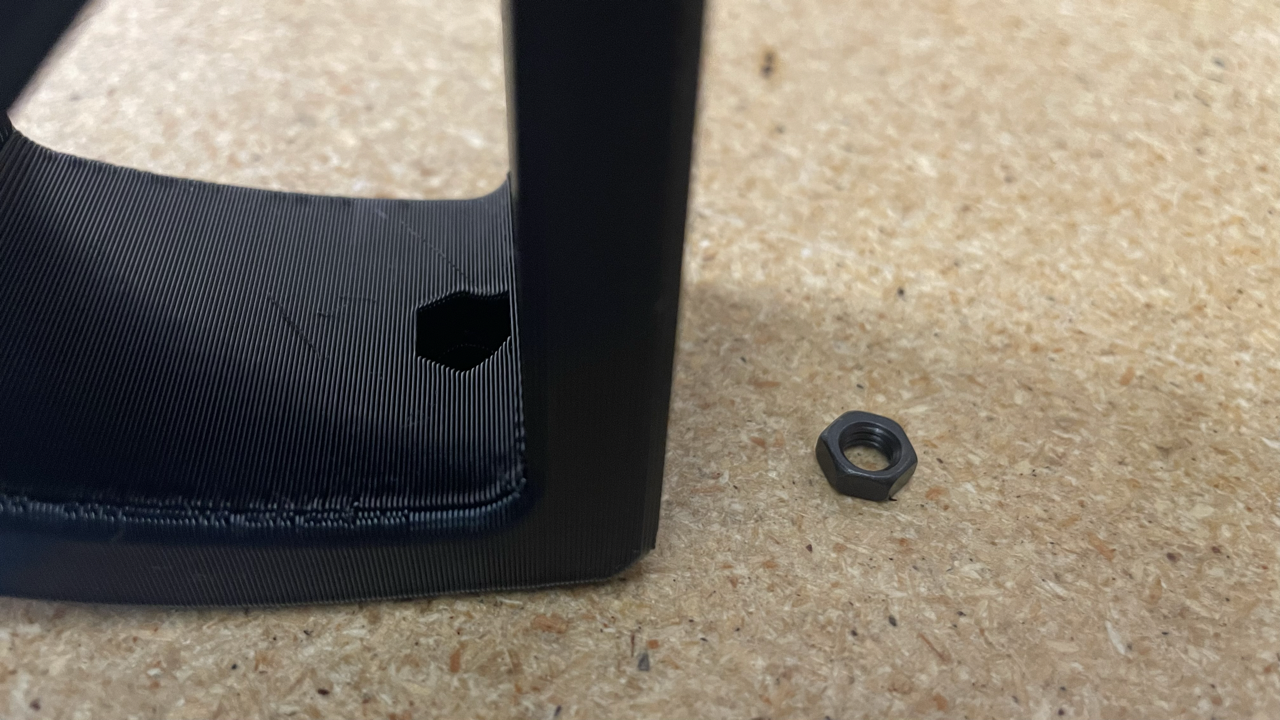
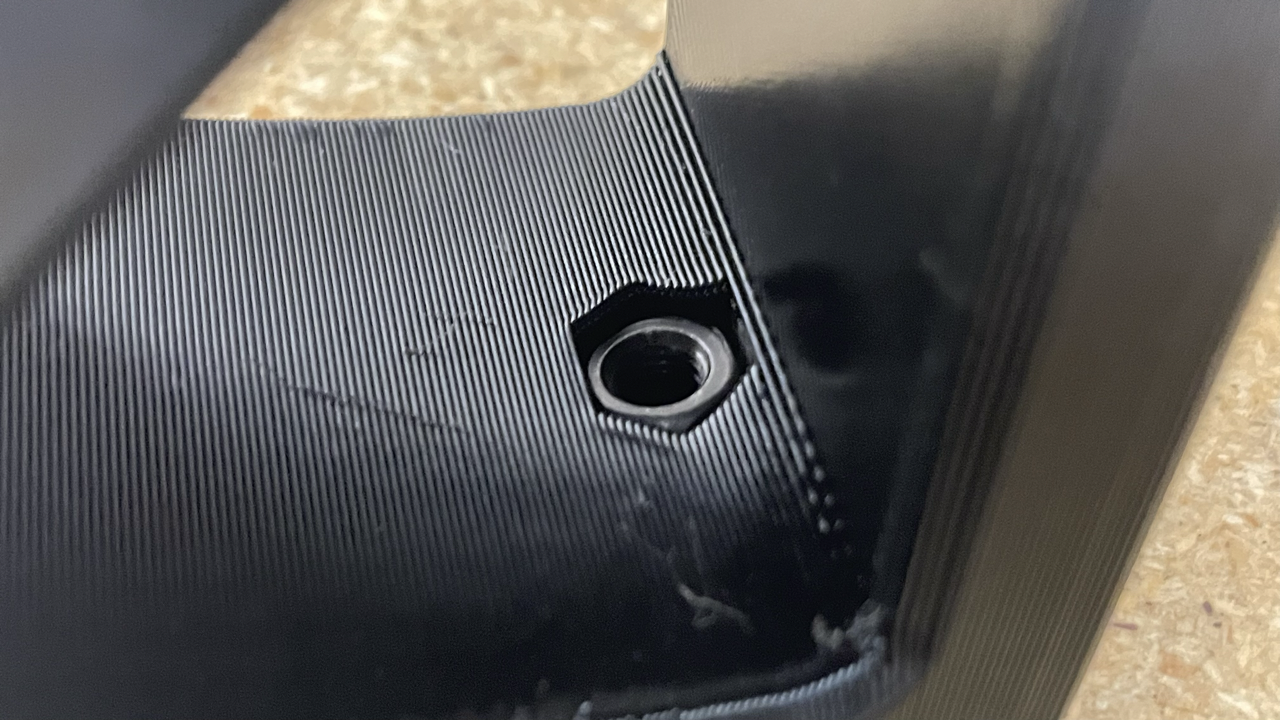
Prepare y-gantry stepper motor
-
Gather the following parts and tools
- nema17-stepper-motor
- GT2-timing-pulley
- y-timing-pulley-spacer-jig
- Torque driver w/2mm hex driver, set to
0.7 N/M(not shown)
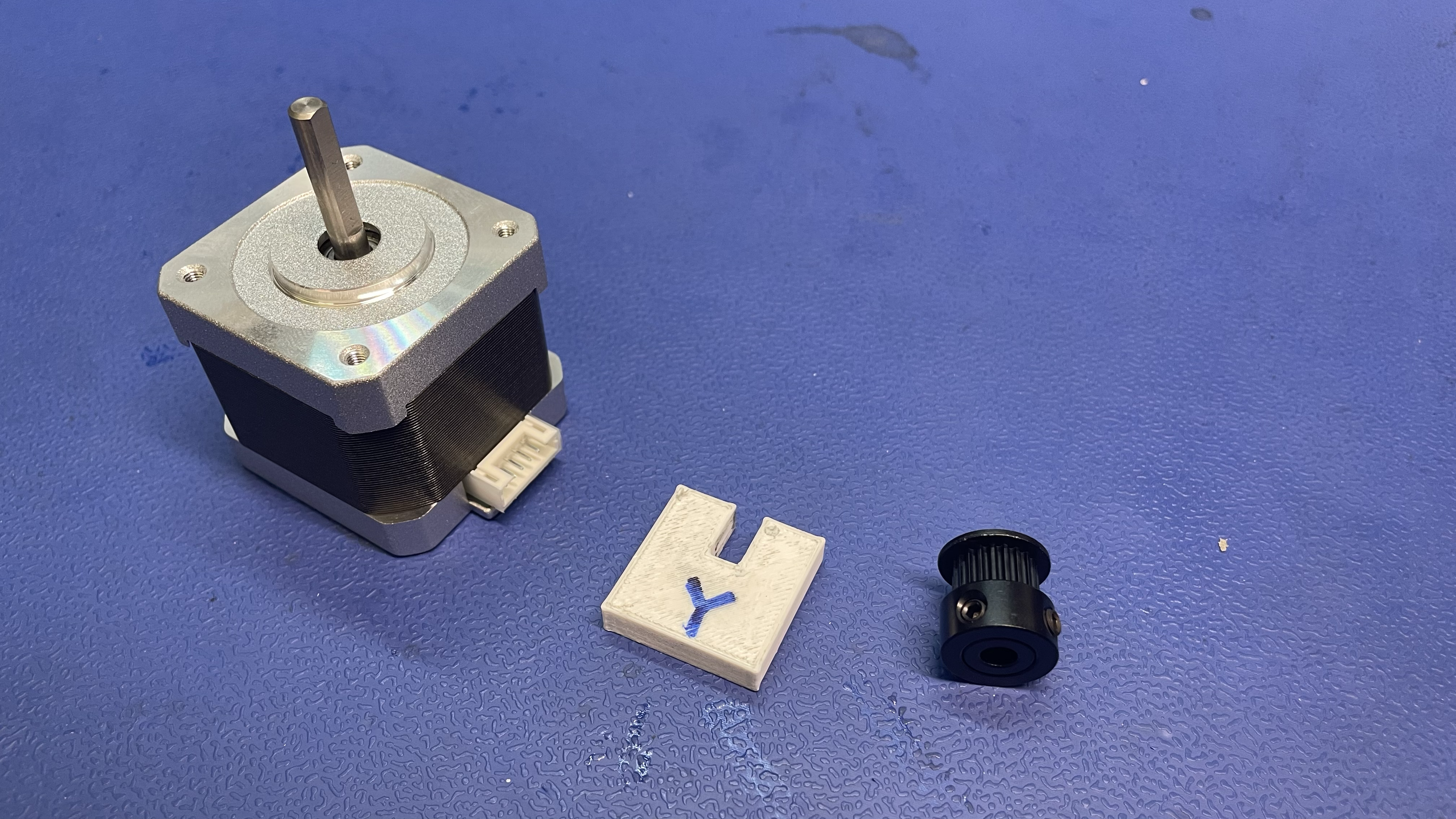 - Use motor spacing jig to mount the timing pulley to the NEMA 17, ensuring the set screw is aligned to the flat side of the motor shaft
- Use motor spacing jig to mount the timing pulley to the NEMA 17, ensuring the set screw is aligned to the flat side of the motor shaft
 - Tighten the 2x timing pulley set screws to 0.7 N/M - first tightening the one facing the flat on the motor shaft
- Tighten the 2x timing pulley set screws to 0.7 N/M - first tightening the one facing the flat on the motor shaft
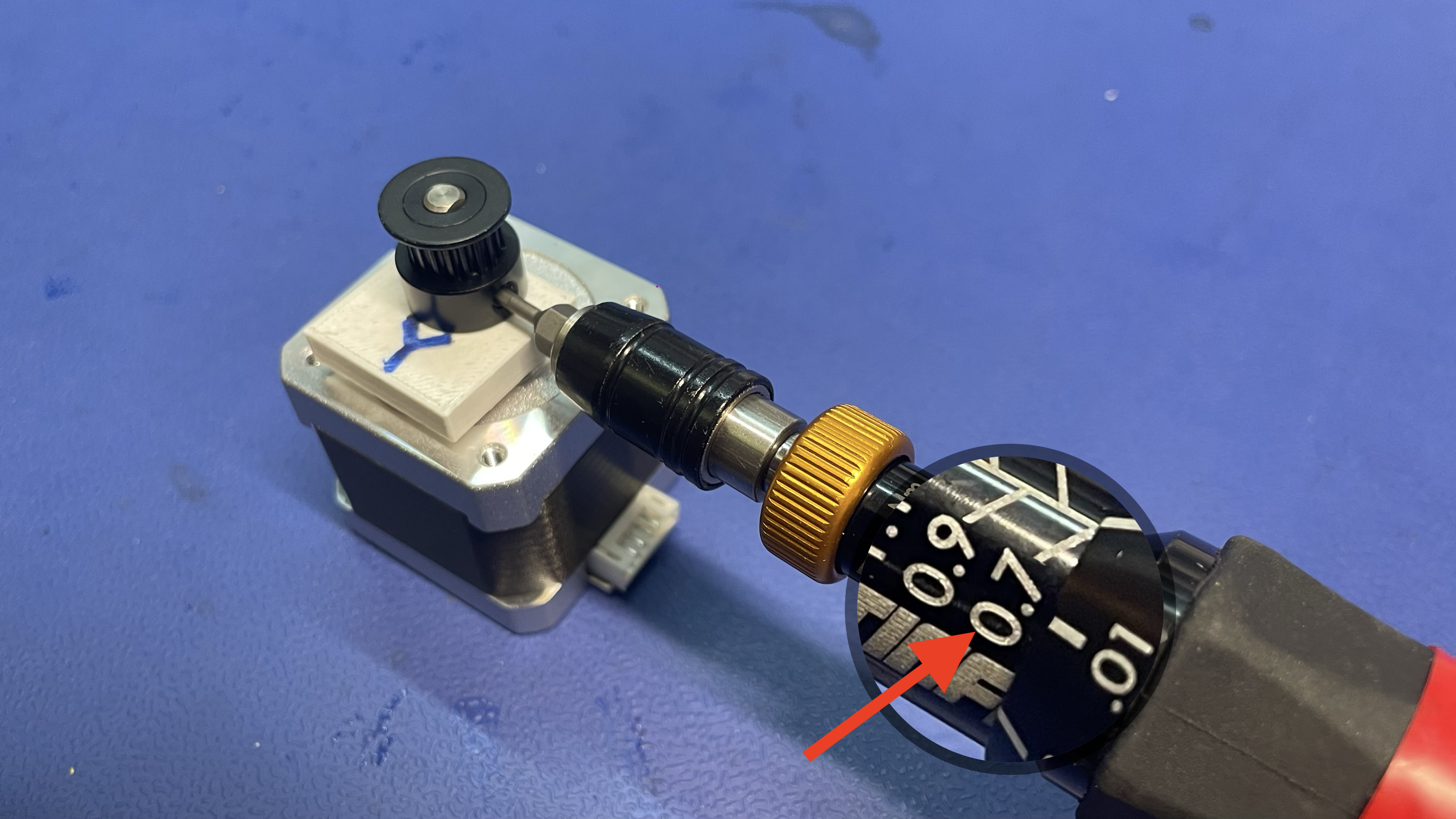
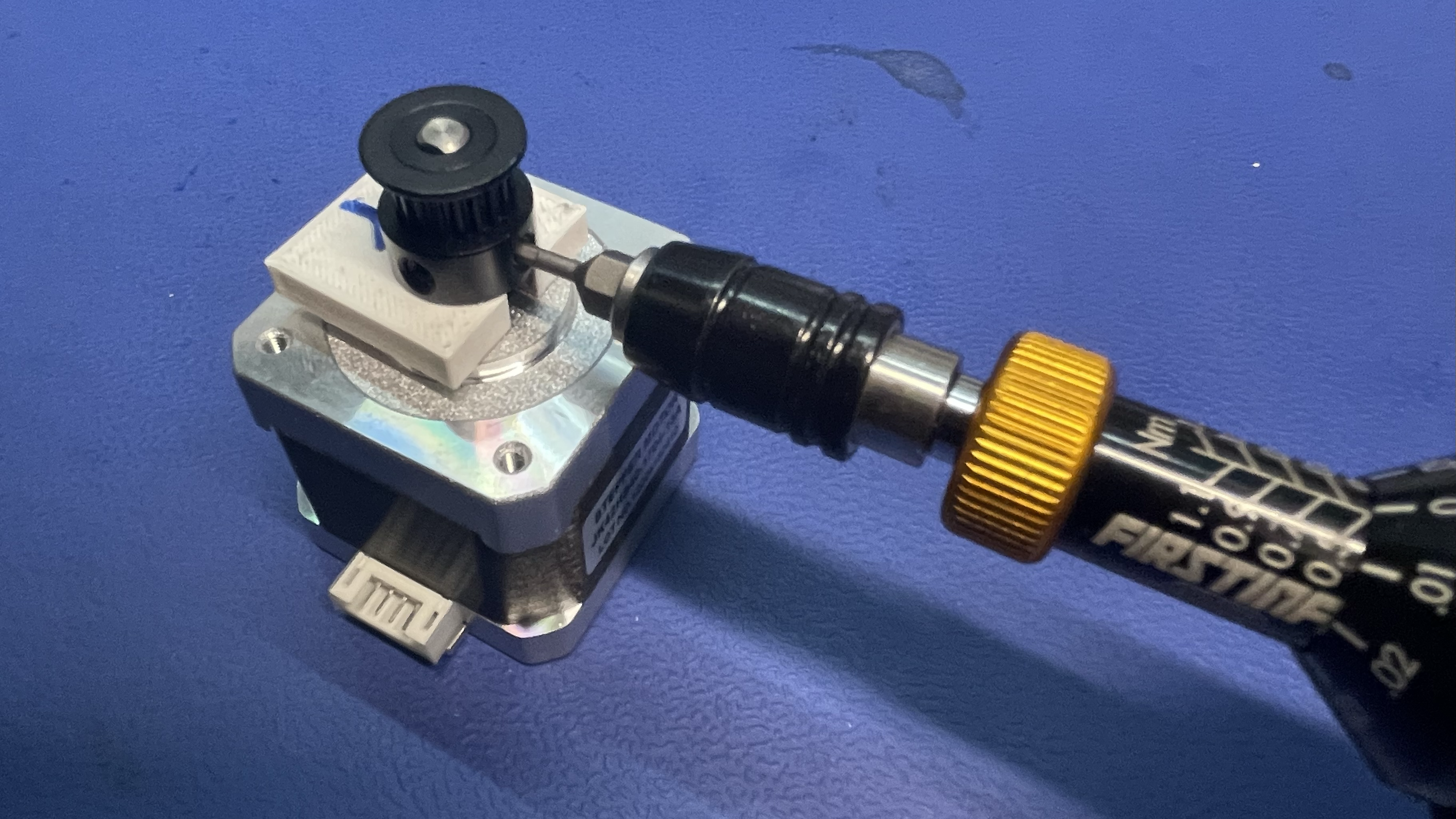
Install y-gantry stepper motor onto back-leg
-
Connect
Y1-stepper-motor-cableto they-gantry-stepper-motor
-
Install the
y-gantry-stepper-motorontoback-leg- The
Y1-stepper-motor-cableshould be routed throughback-legto exit towards the center of the machine - Ensure no wires are being crushed or strained
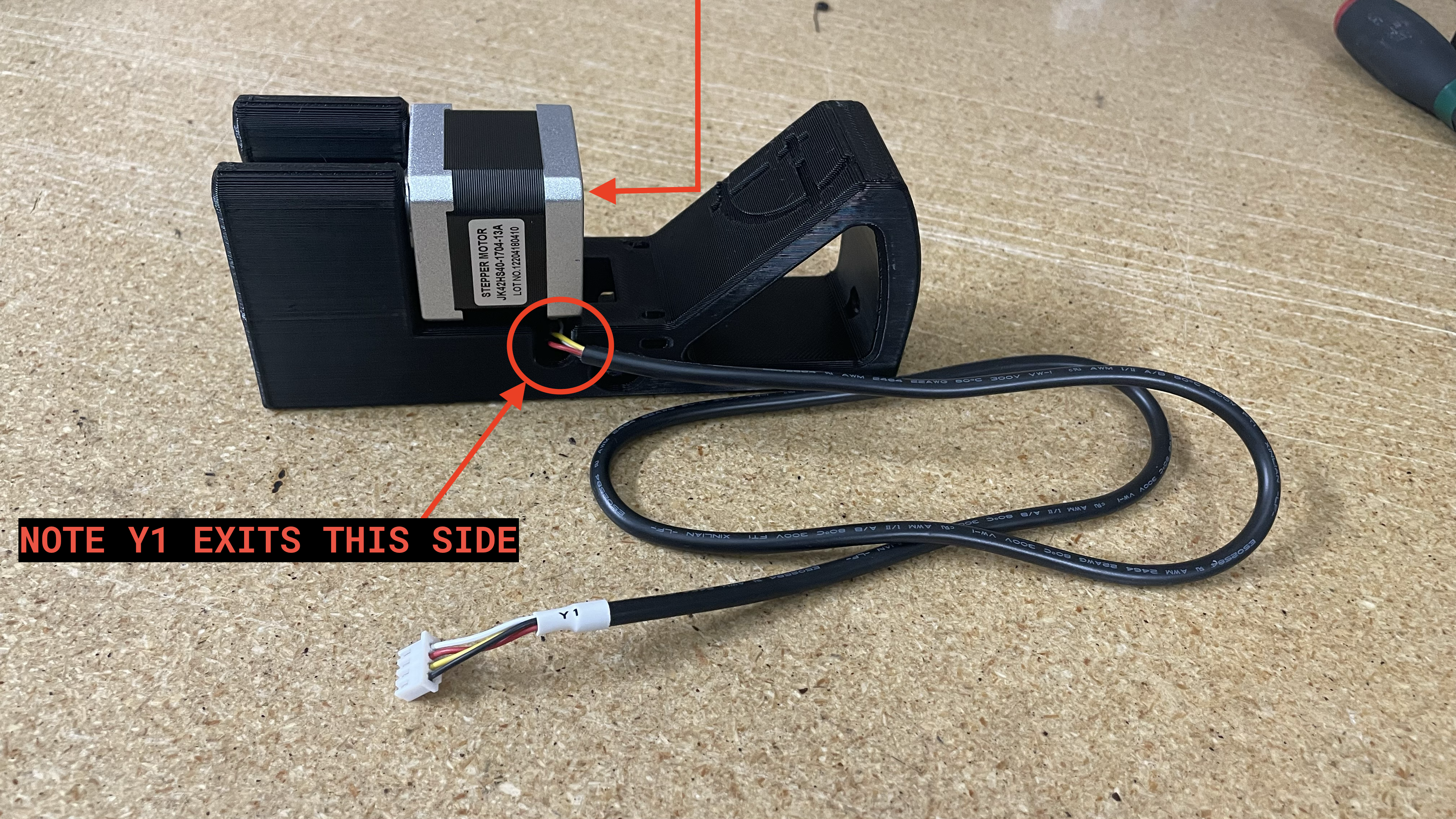
- The
-
Put 4x
M3x8-boltthrough the motor mounting holes found onback-leg
-
Install a
zip-tiefor cable strain relief-
Use a
zip-tieto attached theY1-stepper-motor-cableto theback-legto add strain relief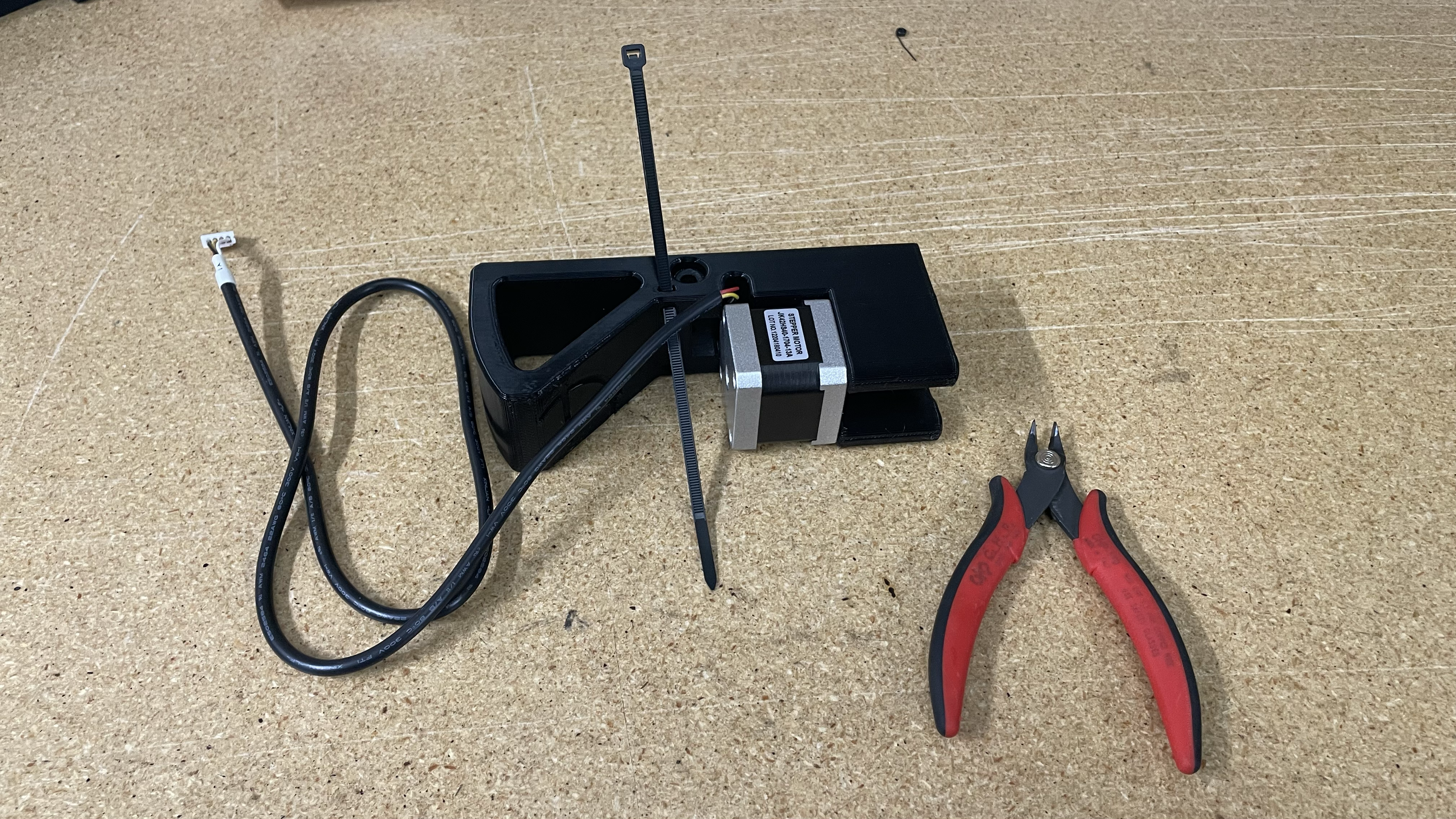
-
Cut the
zip-tiewithflush-cutters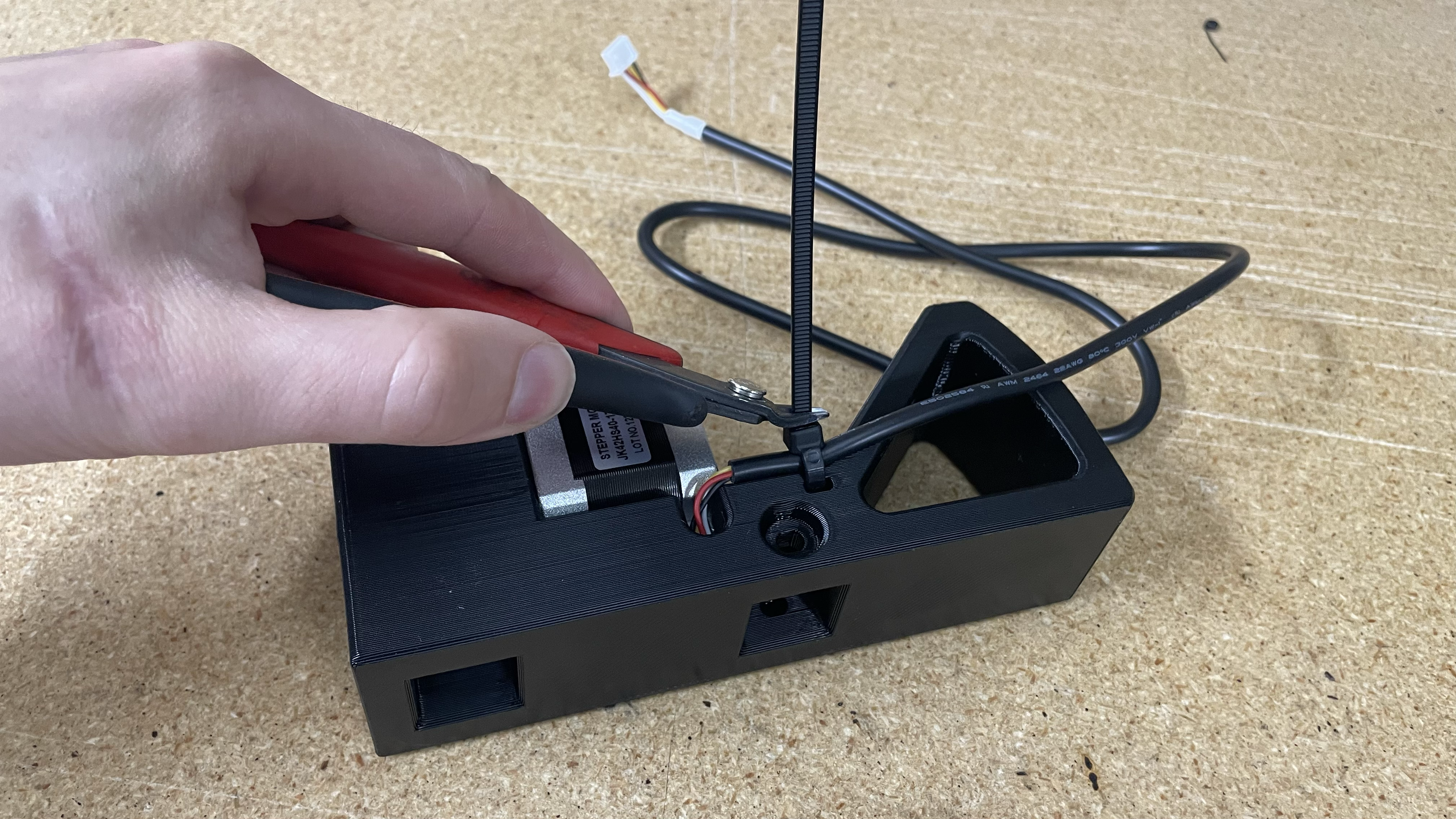
-
Ensure that
Y1-stepper-motor-cableandzip-tieare resting against the logo-face side ofback-leg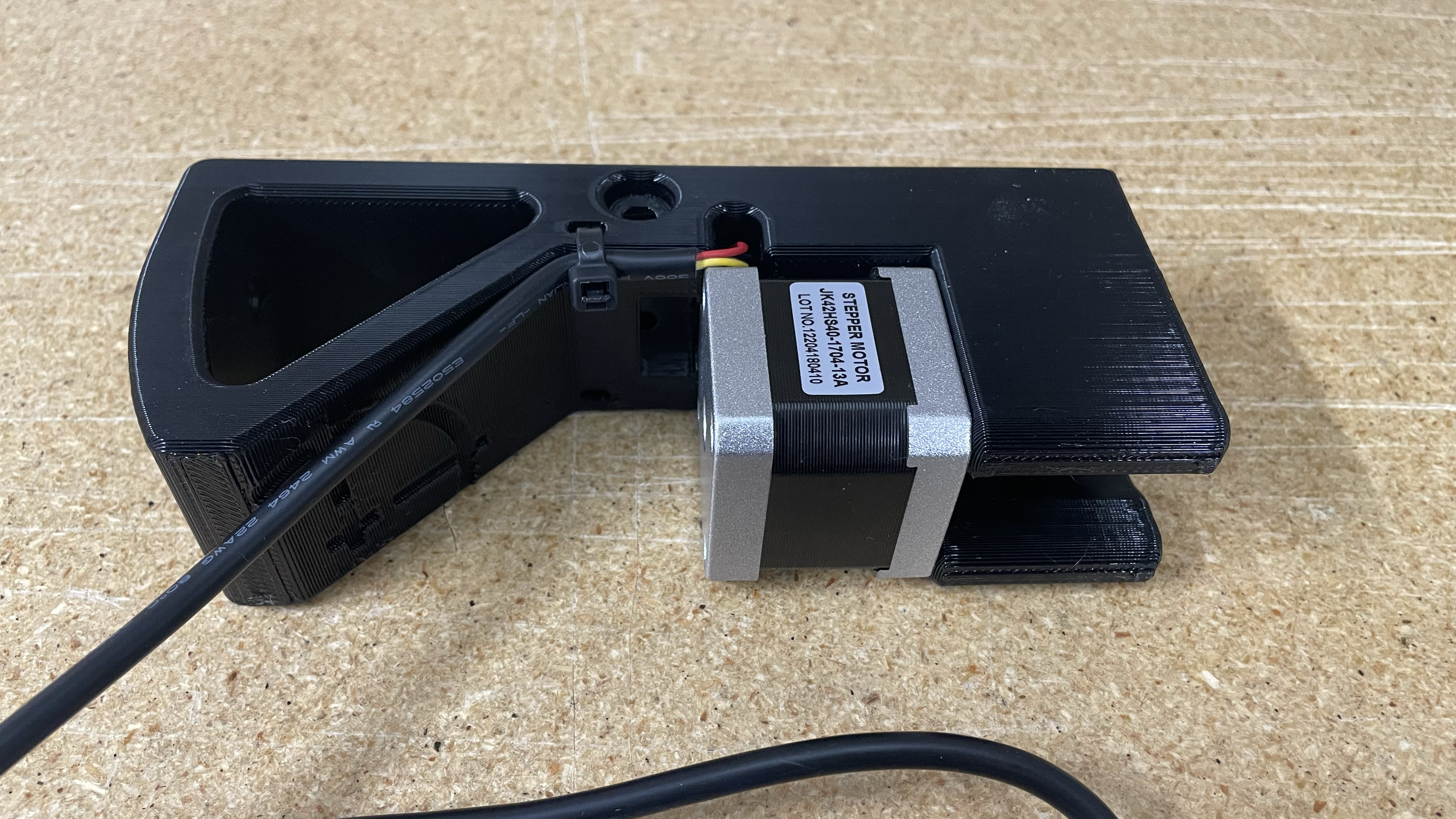
-
Assemble y-gantry-left
Install front-left-leg and back-leg onto alu-extrusion
-
Begin by inserting a
525mm-m3-t-nut-barinto a piece ofalu-extrusion- There should be about 51.5mm between the end of the
525mm-m3-t-nut-barand the right-side end of thealu-extrusionafter installation - The
525mm-m3-t-nut-barneeds to be slide aside in later steps, so do not bother to make this perfect right now
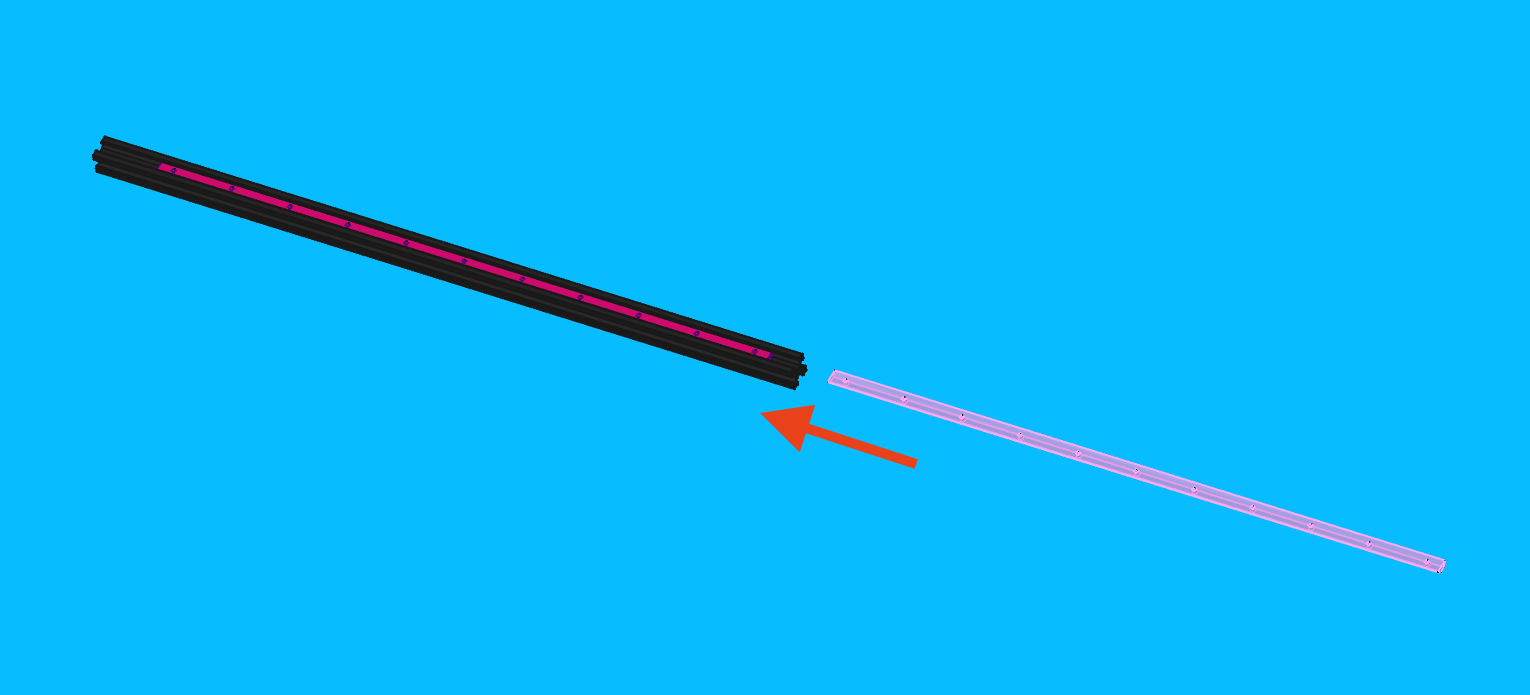
- There should be about 51.5mm between the end of the
-
Insert
front-left-legandback-legonto 2x pieces ofalu-extrusion- The
525mm-m3-t-nut-baris oriented in the top-side groove of the uppermostalu-extrusion - The extrusion pieces should be fully inserted into each leg
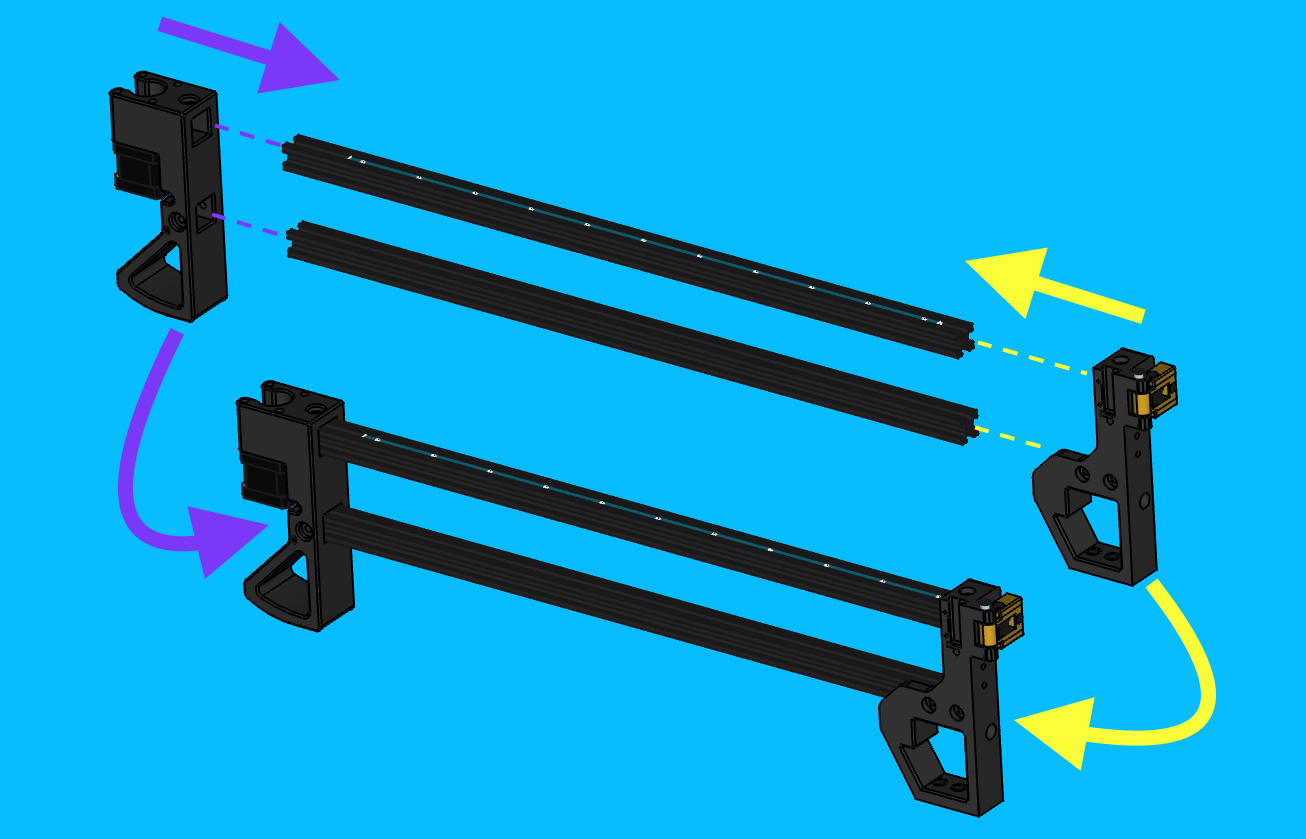
- The
-
Bolt
back-legtoalu-extrusion-
Insert 3x
m3-t-nutinto thealu-extrusionpieces before sliding each of them into alignment with the matching bolt holes onback-leg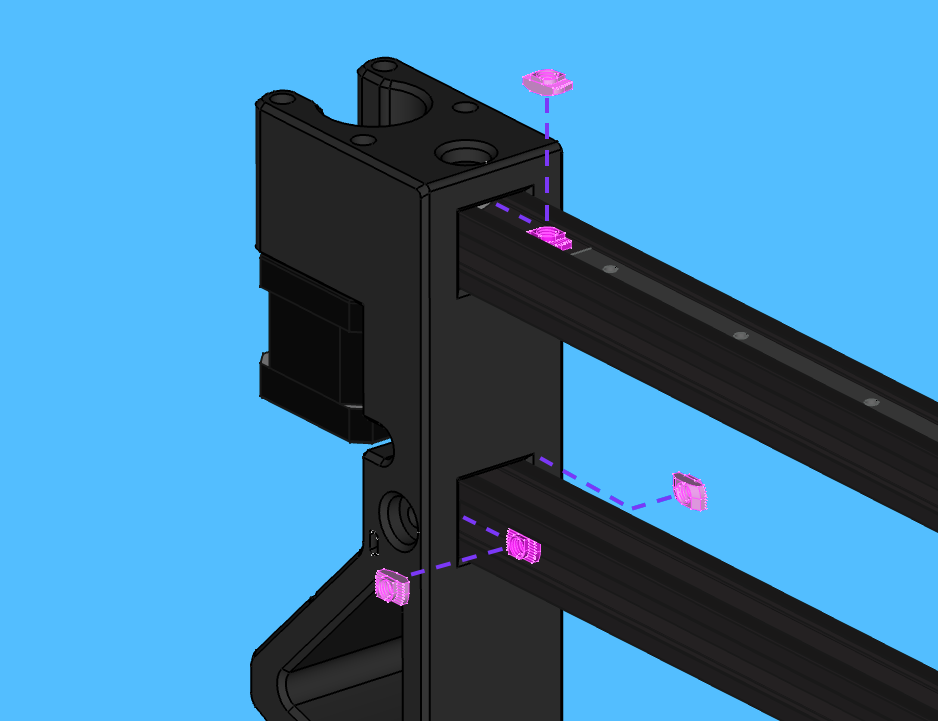
-
Insert 3x
M5x10-boltintoback-legand thread the bolts into each correspondingM5-t-nut
-
-
Bolt
front-left-legtoalu-extrusion- Slide the
M3-t-nut-barout of the way if needed - Insert an
M5-t-nutinto the upper channel ofalu-extrusion -
Align the
M5-t-nutwith the top-side bolt hole onfront-left-leg
-
Insert a
M5x10-boltinto the top-side bolt hole onfront-left-legand tighten it into theM5-t-nut
-
Slide 2x
M5-t-nutinto the the side channel of loweralu-extrusionand align them with the two bolt holes onfront-left-leg
-
Insert 2x
M5x10-boltinto the side bolt holes onfront-left-legand tighten each into the correspondingM5-t-nut
- Slide the
-
Compare the WIP
y-gantry-leftassembly to the image below after completing all previous steps, address any discrepancies as needed before proceeding onward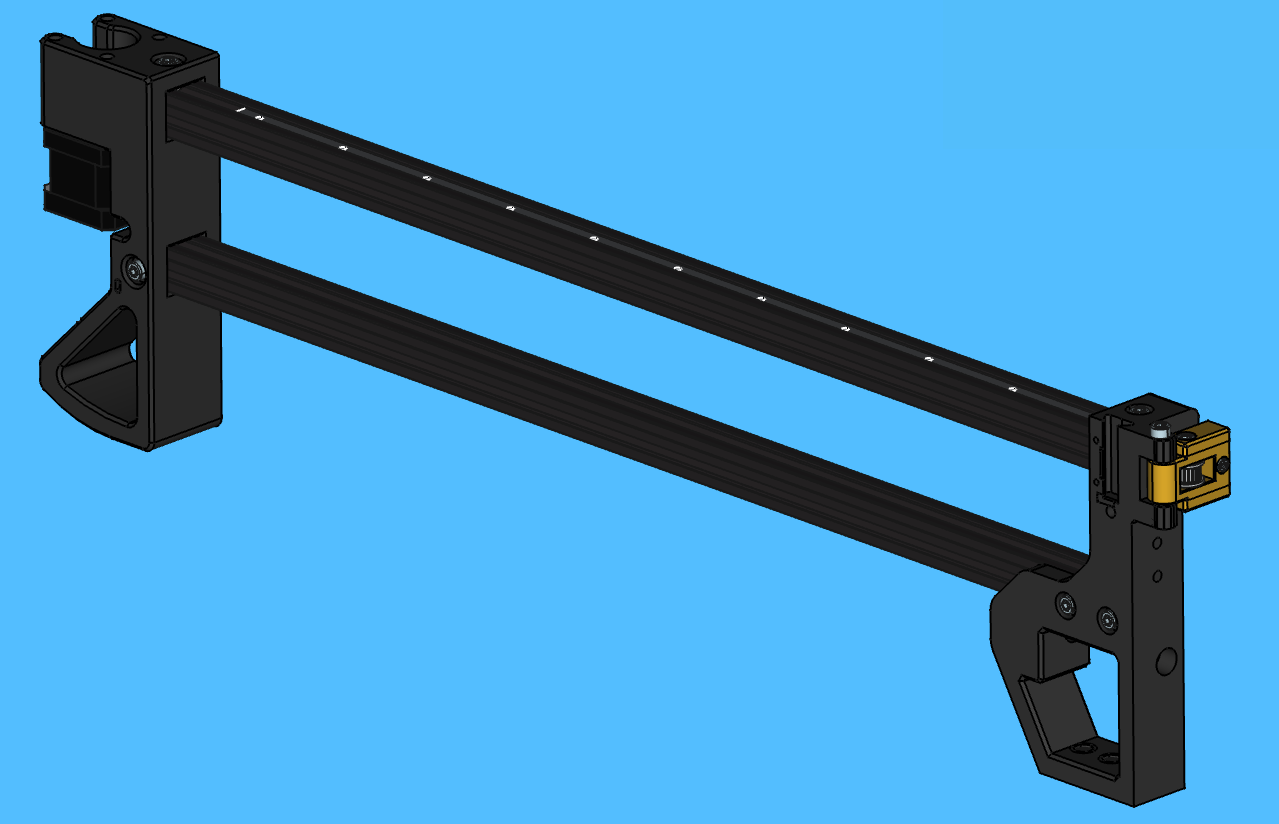
Install linear-rail-550mm
-
Roughtly position
linear-rail-550mmonto top-side of uppermostalu-extrusion
-
Place a
linear-rail-2020-alignment-jigon both ends oflinear-rail-550mm- Do not cover any bolt holes with the jig

-
Visually center the
linear-rail-550mmbetween theback-legandfront-left-leg - Slide the
M3-t-nut-barto line up with the linear rail's bolt hole pattern -
Starting from the
front-left-legside, lightly snug aM3x8-boltinto every other bolt hole onlinear-rail-550mm- Move the
linear-rail-carriageout of the way as needed
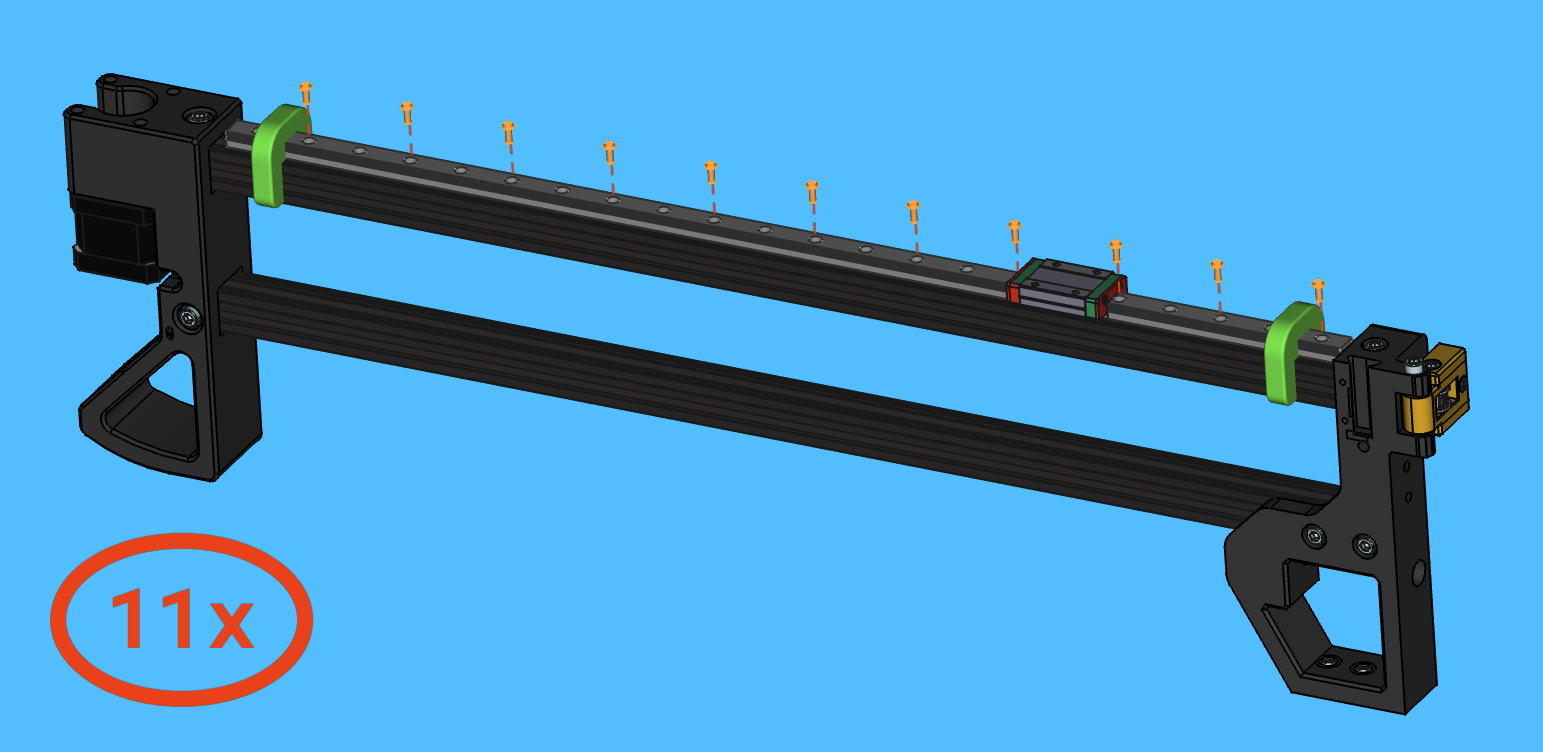
- Move the
-
Torque the rail mounting bolts to specification in sequence beginning with the bolts at the center of the rail and working towards each end
- A torque wrench should be used to set the specified bolt torque
- The torque specification for these
M3x8-boltsis0.5N/M

-
Remove the
linear-rail-2020-alignment-jigfrom both ends oflinear-rail-550mm - Slide the linear-rail-carriage back and forth a few times, checking to see that it travels smoothly and consistently
Halfway Checkpoint
-
Verify that
y-gantry-leftmatches the following photo
If y-gantry-left matches the photo, proceed to the next section
If y-gantry-left does not match the photo, correct discrepancies before proceeding to the next section
Install GT2-belt
-
Route a 1.3m-long piece of
GT2-beltthroughy-gantry-leftBelt routing step-by-step
- Start by running the belt through the
y-gantry's left-side slot and leave 75mm of extra belt poking out - Run it through the extrusion towards the
back-leg - Wrap it around the
timing-pulley - Run it back through the extrusion towards the
front-left-leg - Wrap it around the
idler-pulley - Run it back through the extrusion towards the
back-legagain - Have the belt exit through the
y-gantry's right-side slot

- Start by running the belt through the
-
Slide the
y-gantrysubassembly onto thelinear-rail-carriagewhile pulling slack out of theGT2-belt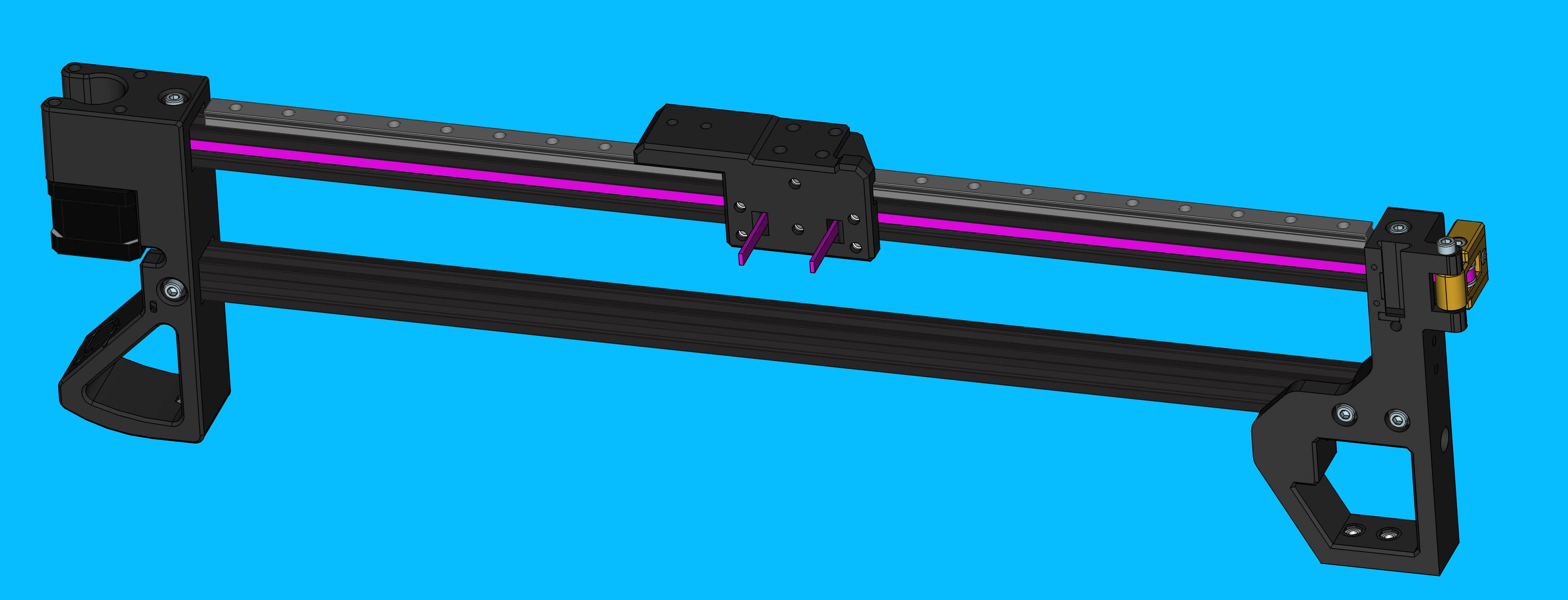

-
Bolt
y-gantryto thelinear-rail-carriagewith 4xM3x8-bolt- Tighten each bolt to 0.5 N/M
- Push
y-gantryinward towards the `linear-rail-carriage while tightening the mounting bolts to align it
Ensure that
y-gantrysits flush againstlinear-rail-carriagewithout any visible gaps
-
Use
belt-clampwith 2xM5x10-boltto clamp the left-side of theGT2-beltto they-gantry- Tighten each
M5x10-boltto 0.5 N.M
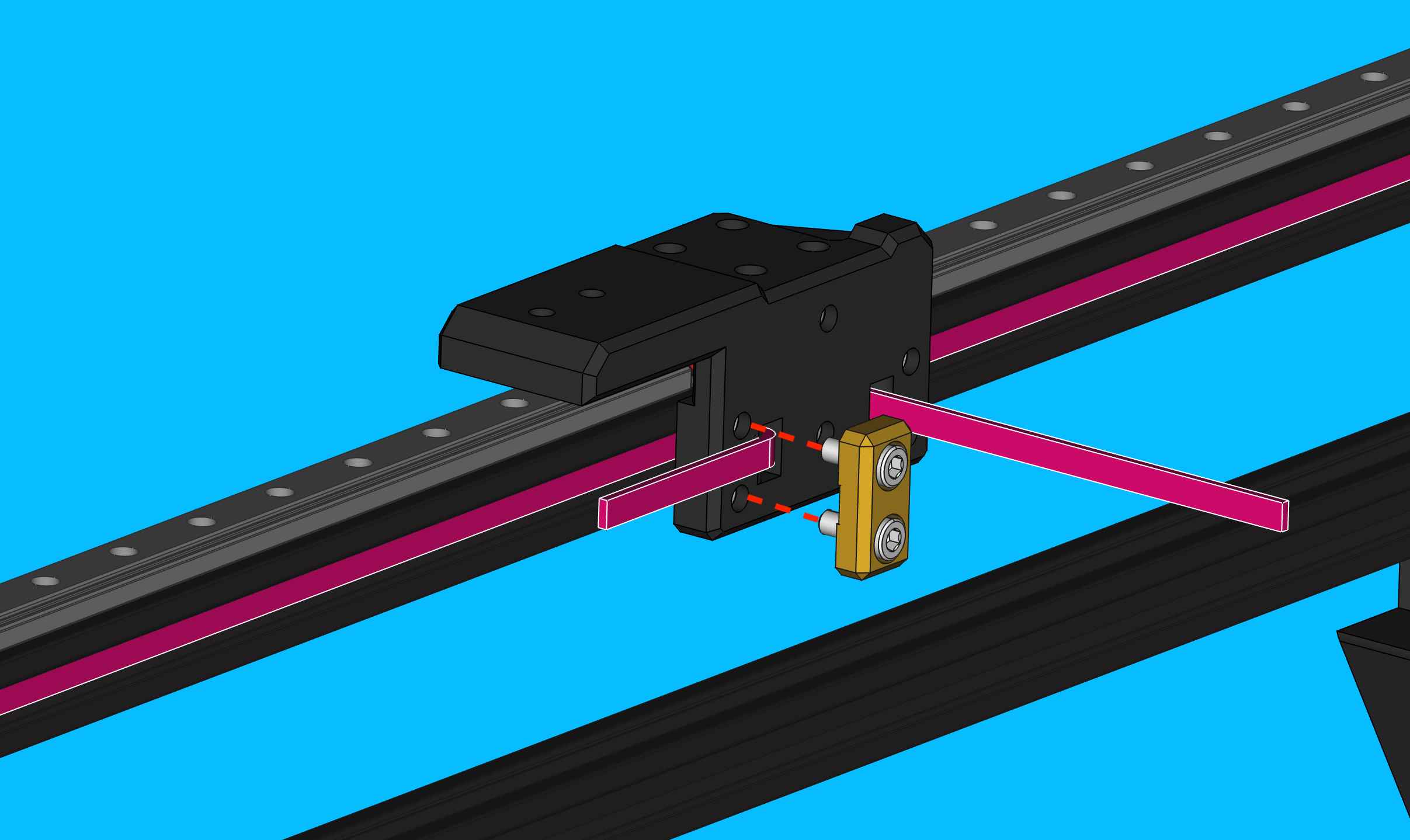
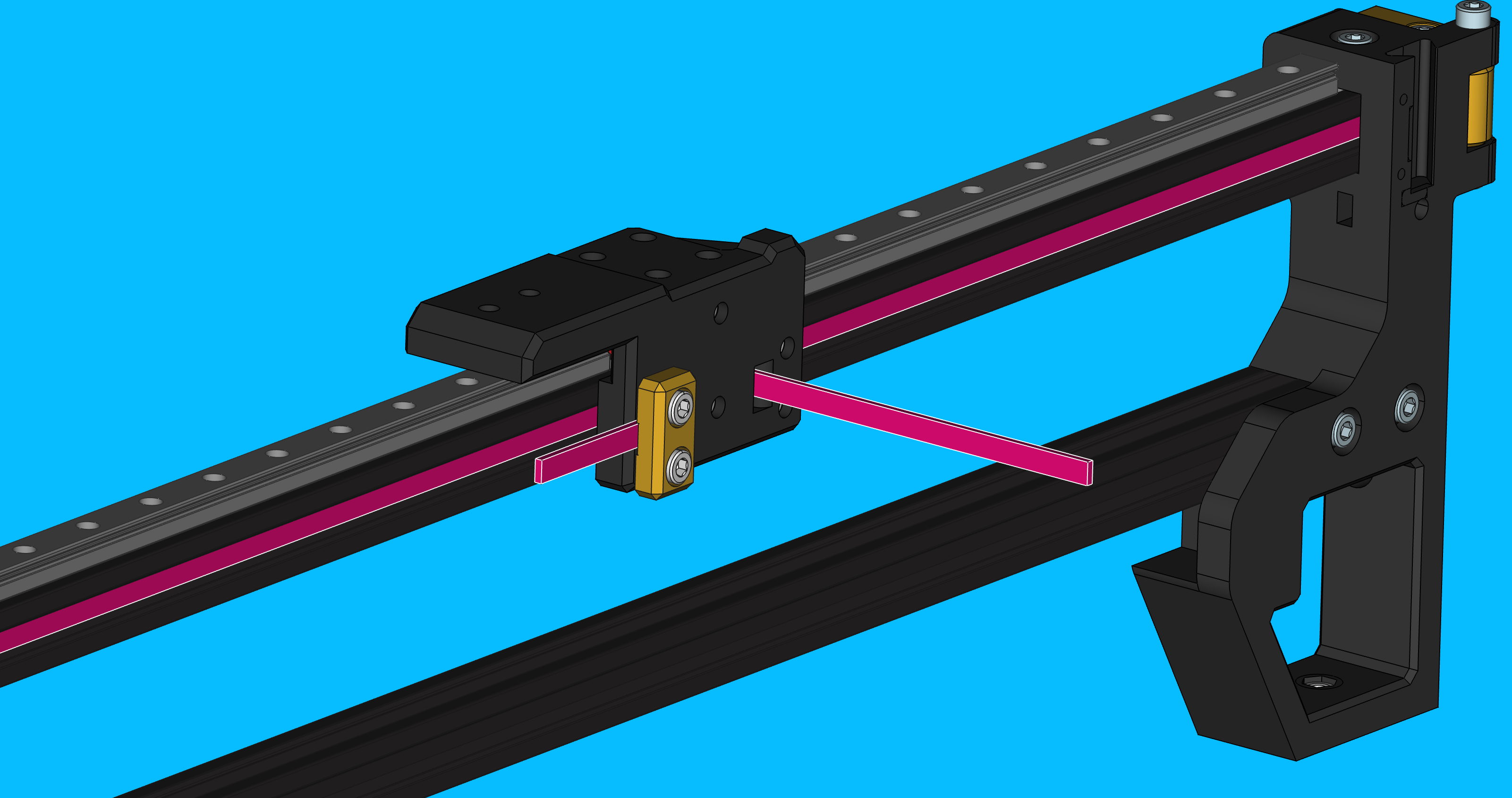
- Tighten each
Tension the Y-Gantry
-
Pull the right-side
GT2-belttightly towardsfront-left-leg
-
Use
belt-clampwith 2xM5x10-boltto clamp the right-sideGT2-beltto they-gantry- Tighten each
M5x10-boltto 0.5 N.M
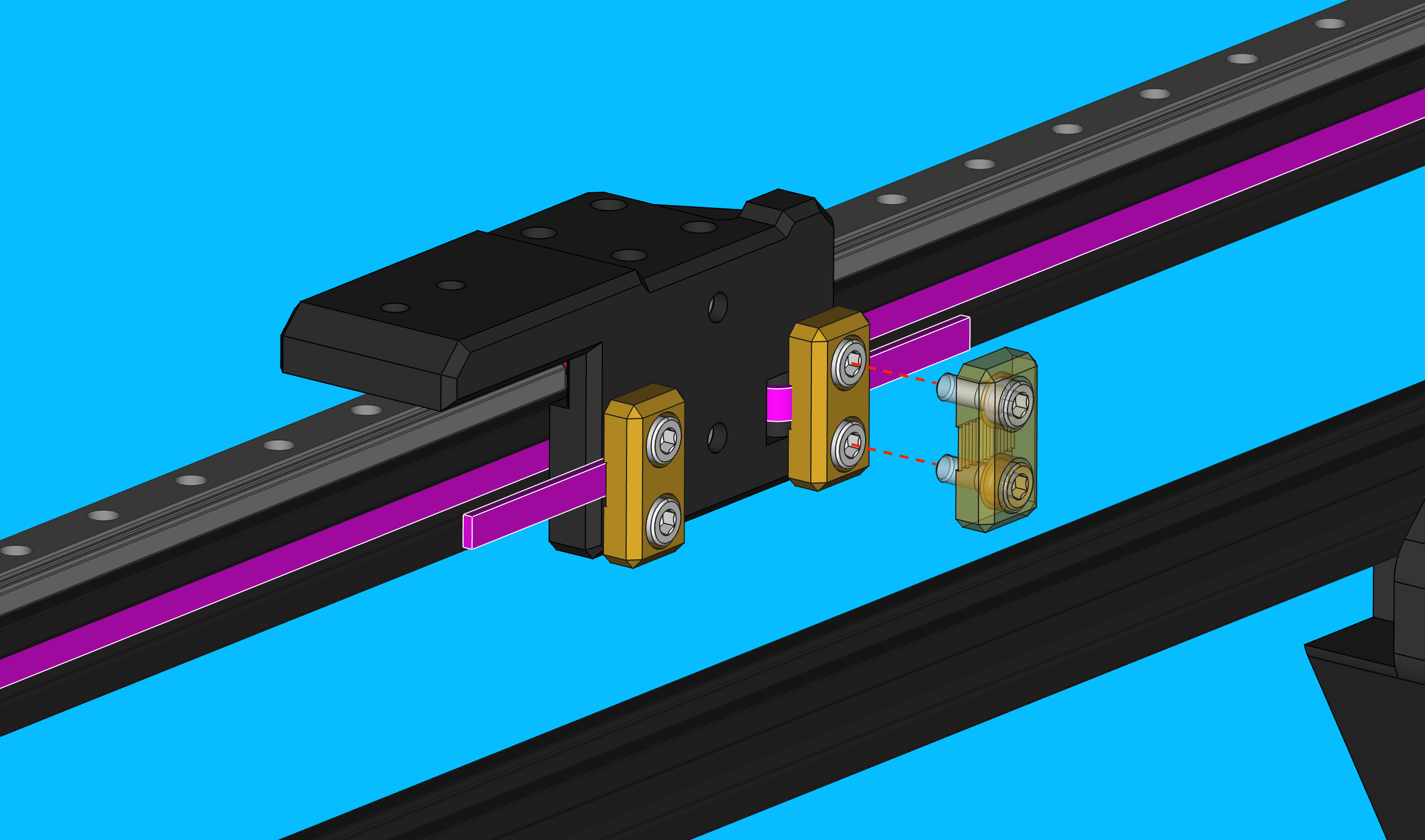
- Tighten each
-
Rotate the
M3x16-boltclockwise on thebelt-tensioner-armto tension theGT2-beltinstalled ony-gantry-left- This will cause the
belt-tensioner-armto pull theidler-pulleyaway from thefront-left-legwhich adds desired tension toGT2-belt

- This will cause the
-
Trim the loose
GT2-belton either side of they-gantry- For the
front-left-legside of they-gantryprint, trim the looseGT2-beltuntil it's flush againstbelt-clamp - For the
back-legside of they-gantryprint, trim the looseGT2-beltuntil there's approx. 15mm ofGT2-beltpastbelt-clamp
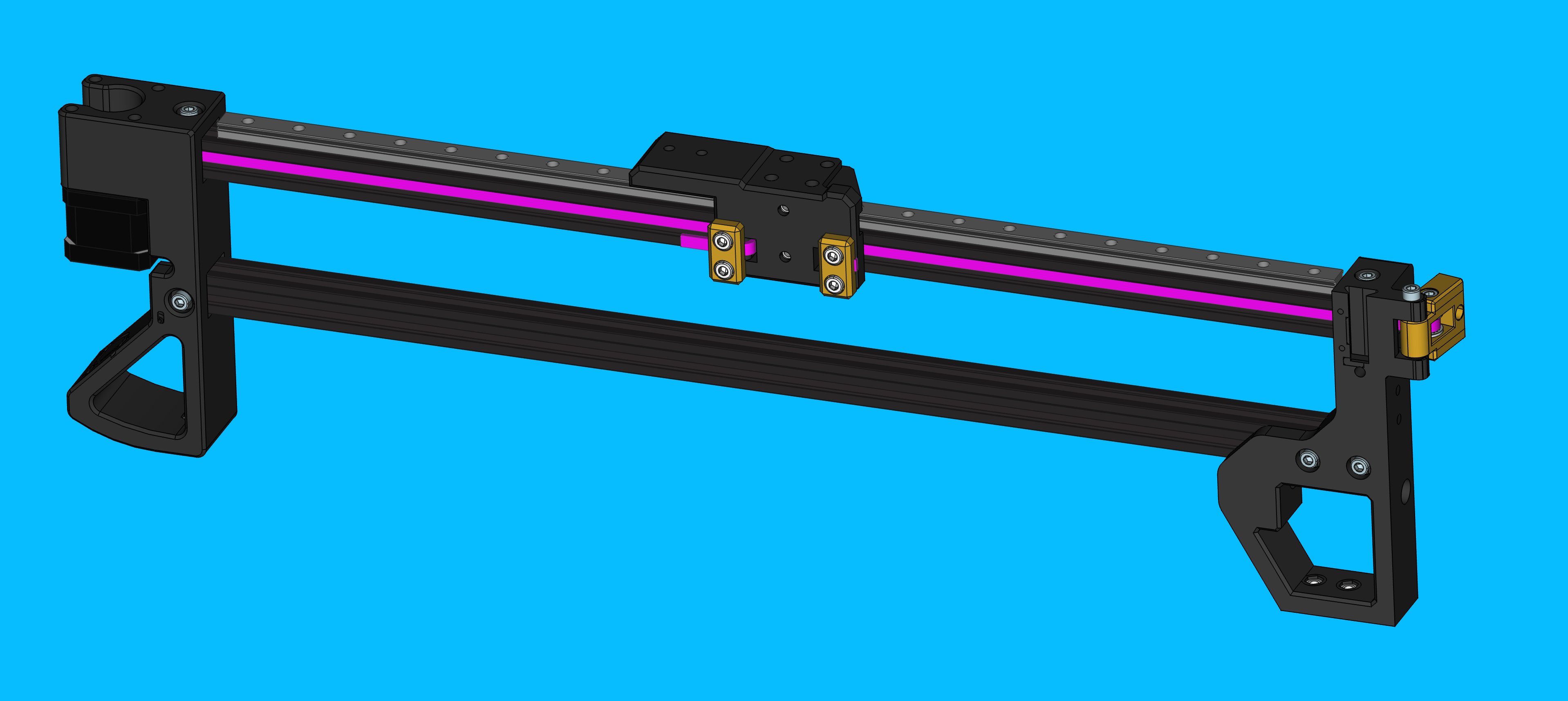
- For the
Add cable management
-
Use 3x
extrusion-cable-clipto secure theY1-stepper-motor-cableto the inner side of the loweralu-extrusion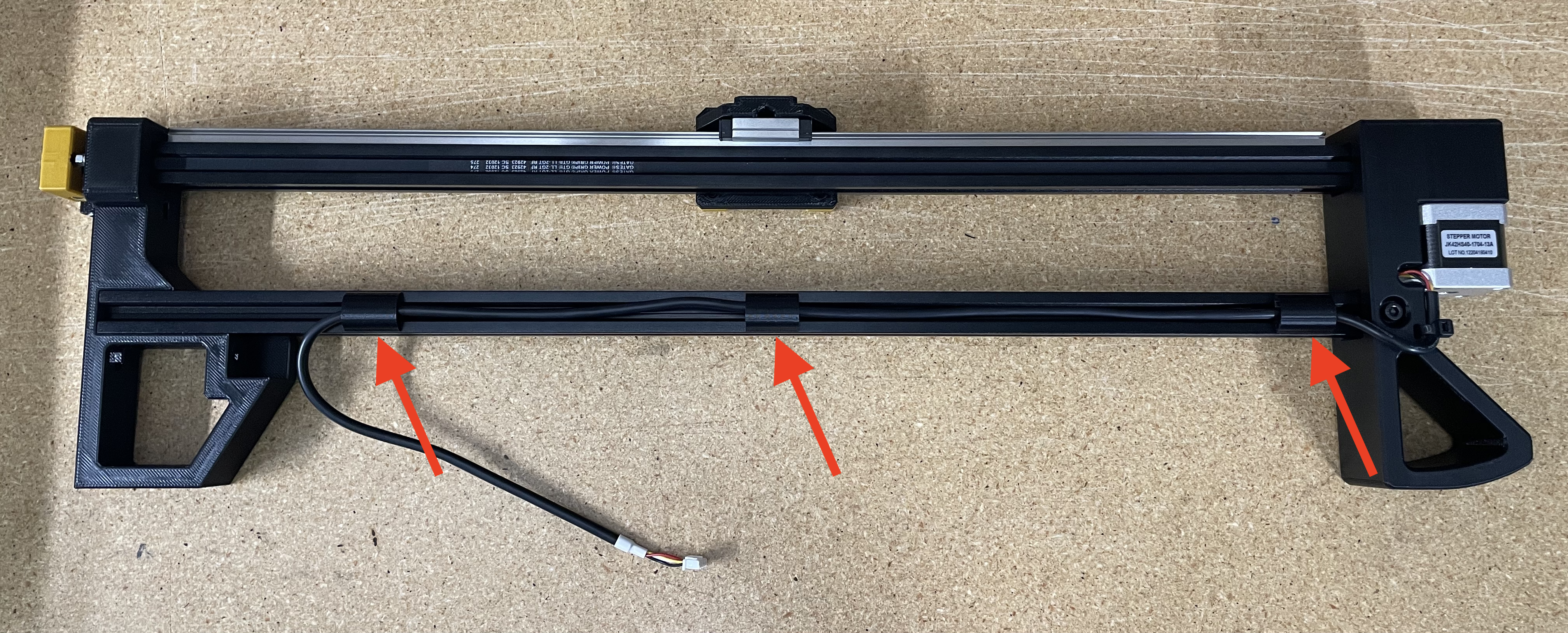
-
Position the right-most
extrusion-cable-clampand the cable to match the following image: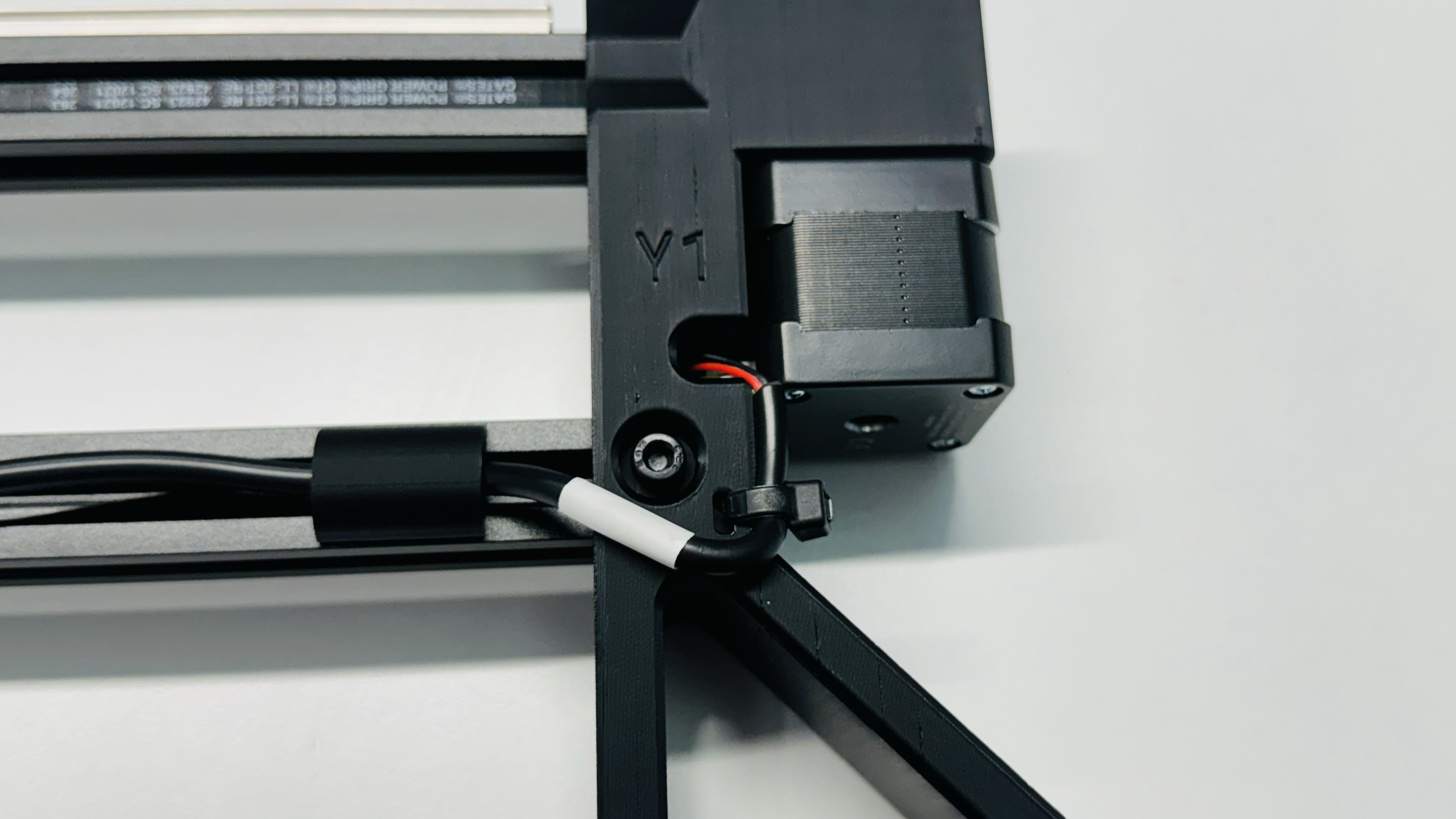
Quality Checks
A y-gantry-left that was built while following the above steps will match the following image.

Confirm this by inspecting the completed y-gantry-left assembly with the following QC checklist:
- Confirm M5 bolts are installed in every counterbored region
-
M5-hex/square-nutinstalled where required:- 2x
M5-hex-nutpressed into bottom offront-left-leg -
1x
M5-square-nutpressed into side offront-left-legfor use withy-limit-strikerThis is only applicable when building y-gantry-left
Please ignore this QC check when building y-gantry-right.
-
1x
M5-hex-nutpressed into bottom ofback-leg - 2x
M5-hex-nutpressed intoy-gantry
- 2x
-
GT2-belthas been trimmed to appropriate length:- Flush on
front-left-legside - Approx. 15mm on
back-legside
- Flush on
GT2-belthas been correctly tensionedGT2-beltlays flat in thealu-extrusionchannelstiming-pulleyis tightened down and at proper heighttensioner-armis installed onfront-left-legin the correct orientation (IE acorn-nut facing touches leg)linear-railis centered atopaluminum-extrusiony-gantry-leftsits flat onlinear-rail-carriagey-gantryfeels smooth and free of friction across the y-min to y-max travel range when actuated by hand- 3x
extrusion-cable-cliphave been installed onto the loweralu-extrusion Y1cable is secured with a zip-tie and exits the port labeledY1
Stay vigilant for new failure modes not listed above and report them to a production lead when found
If all checks pass
Set the finished y-gantry-left aside for Buddy QC testing